The History Book Club discussion

This topic is about
Unreasonable Men
PRESIDENTIAL SERIES
>
OPEN - SPOTLIGHT - PRESIDENTIAL SERIES - GLOSSARY - UNREASONABLE MEN ~ (Spoiler Thread)
 The Muck Rake
The Muck Rake
McClure's (cover, January 1901) published many early muckraker articles
The term muckraker was used in the Progressive Era to characterize reform-minded American journalists who wrote largely for all popular magazines. The modern term is investigative journalism, and investigative journalists today are often informally called "muckrakers." They relied on their own reporting and often worked to expose social ills and corporate and political corruption. Muckraking magazines—notably McClure's of publisher S. S. McClure—took on corporate monopolies and crooked political machines while raising public awareness of chronic urban poverty, unsafe working conditions, and social issues like child labor.
The muckrakers are most commonly associated with the Progressive Era period of American history. The journalistic movement emerged in the United States after 1900 and continued to be influential until World War I, when the movement came to an end through a combination of advertising boycotts, dirty tricks and "patriotism."
Before World War I, the term "muckraker" was used to refer in a general sense to a writer who investigates and publishes truthful reports to perform an auditing or watchdog function. In contemporary use, the term describes either a journalist who writes in the adversarial or alternative tradition, or a non-journalist whose purpose in publication is to advocate reform and change. Investigative journalists view the muckrakers as early influences and a continuation of watchdog journalism.
The term is a reference to a character in John Bunyan's classic Pilgrim's Progress, "the Man with the Muck-rake" that rejected salvation to focus on filth. It became popular after President Theodore Roosevelt referred to the character in a 1906 speech; Roosevelt acknowledged that "the men with the muck rakes are often indispensable to the well being of society; but only if they know when to stop raking the muck..."
While a literature of reform had already appeared by the mid-19th century, the kind of reporting that would come to be called "muckraking" began to appear around 1900. By the 1900s, magazines such as Collier's Weekly, Munsey's Magazine and McClure's Magazine were already in wide circulation and read avidly by the growing middle class. The January 1903 issue of McClure's is considered to be the official beginning of muckraking journalism, although the muckrakers would get their label later. Ida M. Tarbell ("The History of Standard Oil"), Lincoln Steffens ("The Shame of Minneapolis") and Ray Stannard Baker ("The Right to Work"), simultaneously published famous works in that single issue. Claude H. Wetmore and Lincoln Steffens' previous article "Tweed Days in St. Louis", in McClure's October 1902 issue was called the first muckraking article.
(Source: Wikipedia)
More:
http://historyofjournalism.onmason.co...
http://www.todayinliterature.com/stor...
https://prezi.com/l_vbwen9ixq8/the-ma...
http://www.americanrhetoric.com/speec...
http://voicesofdemocracy.umd.edu/theo...
http://www.dictionary.com/browse/muck...
 by Arthur Weinberg (no photo)
by Arthur Weinberg (no photo) by Judith Serrin (no photo)
by Judith Serrin (no photo) by Kathleen Brady (no photo)
by Kathleen Brady (no photo) by Ellen F. Fitzpatrick (no photo)
by Ellen F. Fitzpatrick (no photo) by Louis Filler (no photo)
by Louis Filler (no photo) by
by
 Jessica Mitford
Jessica Mitford by
by
 Jessica Mitford
Jessica Mitford
 President William Howard Taft
President William Howard Taft
William Howard Taft was elected the 27th President of the United States (1909-1913) and later became the tenth Chief Justice of the United States (1921-1930), the only person to have served in both of these offices.
Distinguished jurist, effective administrator, but poor politician, William Howard Taft spent four uncomfortable years in the White House. Large, jovial, conscientious, he was caught in the intense battles between Progressives and conservatives, and got scant credit for the achievements of his administration.
Born in 1857, the son of a distinguished judge, he graduated from Yale, and returned to Cincinnati to study and practice law. He rose in politics through Republican judiciary appointments, through his own competence and availability, and because, as he once wrote facetiously, he always had his "plate the right side up when offices were falling."
But Taft much preferred law to politics. He was appointed a Federal circuit judge at 34. He aspired to be a member of the Supreme Court, but his wife, Helen Herron Taft, held other ambitions for him.
His route to the White House was via administrative posts. President McKinley sent him to the Philippines in 1900 as chief civil administrator. Sympathetic toward the Filipinos, he improved the economy, built roads and schools, and gave the people at least some participation in government.
President Roosevelt made him Secretary of War, and by 1907 had decided that Taft should be his successor. The Republican Convention nominated him the next year.
Taft disliked the campaign--"one of the most uncomfortable four months of my life." But he pledged his loyalty to the Roosevelt program, popular in the West, while his brother Charles reassured eastern Republicans. William Jennings Bryan, running on the Democratic ticket for a third time, complained that he was having to oppose two candidates, a western progressive Taft and an eastern conservative Taft.
Progressives were pleased with Taft's election. "Roosevelt has cut enough hay," they said; "Taft is the man to put it into the barn." Conservatives were delighted to be rid of Roosevelt--the "mad messiah."
Taft recognized that his techniques would differ from those of his predecessor. Unlike Roosevelt, Taft did not believe in the stretching of Presidential powers. He once commented that Roosevelt "ought more often to have admitted the legal way of reaching the same ends."
Taft alienated many liberal Republicans who later formed the Progressive Party, by defending the Payne-Aldrich Act which unexpectedly continued high tariff rates. A trade agreement with Canada, which Taft pushed through Congress, would have pleased eastern advocates of a low tariff, but the Canadians rejected it. He further antagonized Progressives by upholding his Secretary of the Interior, accused of failing to carry out Roosevelt's conservation policies.
In the angry Progressive onslaught against him, little attention was paid to the fact that his administration initiated 80 antitrust suits and that Congress submitted to the states amendments for a Federal income tax and the direct election of Senators. A postal savings system was established, and the Interstate Commerce Commission was directed to set railroad rates.
In 1912, when the Republicans renominated Taft, Roosevelt bolted the party to lead the Progressives, thus guaranteeing the election of Woodrow Wilson.
Taft, free of the Presidency, served as Professor of Law at Yale until President Harding made him Chief Justice of the United States, a position he held until just before his death in 1930. To Taft, the appointment was his greatest honor; he wrote: "I don't remember that I ever was President."
(Source: The White House)
More:
https://en.wikipedia.org/wiki/William...
http://www.history.com/topics/us-pres...
http://www.biography.com/people/willi...
http://millercenter.org/president/taft
http://blog.constitutioncenter.org/20...
http://www.americaslibrary.gov/jb/ref...
http://www.britannica.com/biography/W...
https://www.nps.gov/wiho/index.htm
https://www.jstor.org/stable/27547774...
(no image)The Life and Times of William Howard Taft: A Biography, Volume 2 by Henry F. Pringle (no photo)
(no image)The Foreign Policies Of The Taft Administration by Walter Vinton Scholes (no photo)
 by Donald F. Anderson (no photo)
by Donald F. Anderson (no photo) by David Henry Burton (no photo)
by David Henry Burton (no photo) by Paolo E. Coletta (no photo)
by Paolo E. Coletta (no photo) by Paolo E. Coletta (no photo)
by Paolo E. Coletta (no photo)
 Belle Case La Follette
Belle Case La Follette
Belle Case La Follette (April 21, 1859 – August 18, 1931) was a lawyer and a women's suffrage activist in Wisconsin, USA. La Follette worked with the women's peace party during World War I. At the time of her death in 1931, the New York Times called her "probably the least known yet most influential of all the American women who had to do with public affairs in this country".
She is best remembered as the wife and helpmate of Robert “Fighting Bob” La Follette—a prominent Progressive Republican politician both in Wisconsin and on the national scene—and as co-editor with her husband of La Follette’s Weekly Magazine.
Belle Case was born on April 21, 1859 in Summit, Juneau County, Wisconsin. Her parents were Unitarian of English and Scottish descent. She attended the University of Wisconsin–Madison from 1875 to 1879 and, upon graduation, taught high school in Spring Green and junior high school in Baraboo. One of her students in Baraboo was John Ringling, of whom she later wrote "... when John read a long account -- interrupted with giggles from the school -- of the side shows he and other boys had been giving every night, I lectured him and drew the moral that if John would put his mind on his lessons as he did on side shows, he might yet become a scholar. Fortunately the scolding had no effect."
She married her former classmate at the University, Robert Marion La Follette Sr., on December 31, 1881. The ceremony was performed by a Unitarian minister and by mutual agreement, the word “obey” was omitted from the marriage vows. Their first child, Flora Dodge La Follette, always called “Fola”, was born on September 10, 1882. Fola married the playwright George Middleton on October 29, 1911.
Belle Case La Follette returned to the University of Wisconsin Law School and became the school’s first woman graduate in 1885. She never practiced as an attorney but she assisted her husband and he frequently acknowledged her authorship or contribution to a brief. She supported and assisted her husband as he rose through the political offices of Dane County District Attorney, United States Representative, Governor of Wisconsin, United States Senator, and Presidential candidate.
Her other children were Robert Jr., born in 1895, who succeeded his father as Senator; Philip, born in 1897, who became Governor of Wisconsin; and Mary, born in 1899. Her sons began the Wisconsin Progressive Party, which briefly held a dominant role in Wisconsin politics.
Belle lectured on women’s suffrage and other topics of the day. In 1909 she edited the “Home and Education” column in the magazine started by her husband, La Follette’s Weekly Magazine, which later became The Progressive. In 1911 and 1912 she wrote a syndicated column for the North American Press Syndicate. In 1914 Belle addressed the colored Young Men's Christian Association, raising an argument that segregation of colored people on street cars, public conveyances, and government departments was wrong. She added there would be no constitution of peace until the question is "settled right".
When suffragists made appearances at more than 70 county fairs in 1912, Belle Case visited seven of them in 10 days. In 1915 she helped found the Woman’s Peace Party, which later became the Women’s International League for Peace and Freedom. After World War I, she was active in the Women’s Committee for World Disarmament, and helped found the National Council for the Prevention of War in 1921. She and other women influenced governments to convene the Naval Arms Limitation Conference in 1922.
After her husband’s death on June 18, 1925, his seat in the United States Senate was offered to her, but she turned down the opportunity to become the first woman Senator, perhaps because it would have upset the very balance between her public and private lives that she is esteemed for.
She died on August 18, 1931 in Washington D.C., as the result of a punctured intestine and peritonitis following a routine medical exam. She was buried in Forest Hill Cemetery in Madison. (Source: Wikipedia)
More:
http://wimedialab.org/biographies/laf...
http://badgerbios.blogspot.hr/p/bell-...
http://www.wisconsinhistory.org/Conte...
http://spartacus-educational.com/USAW...
http://womeninwisconsin.org/belle-cas...
http://www.marketwatch.com/story/suff...
https://news.google.com/newspapers?id...
http://query.nytimes.com/gst/abstract...
 by Lucy Freeman (no photo)
by Lucy Freeman (no photo) by Bernard A. Weisberger (no photo)
by Bernard A. Weisberger (no photo) by Nancy C. Unger (no photo)
by Nancy C. Unger (no photo) by Bob Kann (no photo)
by Bob Kann (no photo) by Greta Anderson (no photo)
by Greta Anderson (no photo)
The Antitrust Laws
Congress passed the first antitrust law, the Sherman Act, in 1890 as a "comprehensive charter of economic liberty aimed at preserving free and unfettered competition as the rule of trade."
In 1914, Congress passed two additional antitrust laws: the Federal Trade Commission Act, which created the FTC, and the Clayton Act. With some revisions, these are the three core federal antitrust laws still in effect today.
The antitrust laws proscribe unlawful mergers and business practices in general terms, leaving courts to decide which ones are illegal based on the facts of each case. Courts have applied the antitrust laws to changing markets, from a time of horse and buggies to the present digital age. Yet for over 100 years, the antitrust laws have had the same basic objective: to protect the process of competition for the benefit of consumers, making sure there are strong incentives for businesses to operate efficiently, keep prices down, and keep quality up.
Here is an overview of the three core federal antitrust laws.
The Sherman Act outlaws "every contract, combination, or conspiracy in restraint of trade," and any "monopolization, attempted monopolization, or conspiracy or combination to monopolize." Long ago, the Supreme Court decided that the Sherman Act does not prohibit every restraint of trade, only those that are unreasonable. For instance, in some sense, an agreement between two individuals to form a partnership restrains trade, but may not do so unreasonably, and thus may be lawful under the antitrust laws. On the other hand, certain acts are considered so harmful to competition that they are almost always illegal. These include plain arrangements among competing individuals or businesses to fix prices, divide markets, or rig bids. These acts are "per se" violations of the Sherman Act; in other words, no defense or justification is allowed.
The penalties for violating the Sherman Act can be severe. Although most enforcement actions are civil, the Sherman Act is also a criminal law, and individuals and businesses that violate it may be prosecuted by the Department of Justice. Criminal prosecutions are typically limited to intentional and clear violations such as when competitors fix prices or rig bids. The Sherman Act imposes criminal penalties of up to $100 million for a corporation and $1 million for an individual, along with up to 10 years in prison. Under federal law, the maximum fine may be increased to twice the amount the conspirators gained from the illegal acts or twice the money lost by the victims of the crime, if either of those amounts is over $100 million.
The Federal Trade Commission Act bans "unfair methods of competition" and "unfair or deceptive acts or practices." The Supreme Court has said that all violations of the Sherman Act also violate the FTC Act. Thus, although the FTC does not technically enforce the Sherman Act, it can bring cases under the FTC Act against the same kinds of activities that violate the Sherman Act. The FTC Act also reaches other practices that harm competition, but that may not fit neatly into categories of conduct formally prohibited by the Sherman Act. Only the FTC brings cases under the FTC Act.
The Clayton Act addresses specific practices that the Sherman Act does not clearly prohibit, such as mergers and interlocking directorates (that is, the same person making business decisions for competing companies). Section 7 of the Clayton Act prohibits mergers and acquisitions where the effect "may be substantially to lessen competition, or to tend to create a monopoly." As amended by the Robinson-Patman Act of 1936, the Clayton Act also bans certain discriminatory prices, services, and allowances in dealings between merchants. The Clayton Act was amended again in 1976 by the Hart-Scott-Rodino Antitrust Improvements Act to require companies planning large mergers or acquisitions to notify the government of their plans in advance. The Clayton Act also authorizes private parties to sue for triple damages when they have been harmed by conduct that violates either the Sherman or Clayton Act and to obtain a court order prohibiting the anticompetitive practice in the future.
In addition to these federal statutes, most states have antitrust laws that are enforced by state attorneys general or private plaintiffs. Many of these statutes are based on the federal antitrust laws.
Source: Federal Trade Commission
Congress passed the first antitrust law, the Sherman Act, in 1890 as a "comprehensive charter of economic liberty aimed at preserving free and unfettered competition as the rule of trade."
In 1914, Congress passed two additional antitrust laws: the Federal Trade Commission Act, which created the FTC, and the Clayton Act. With some revisions, these are the three core federal antitrust laws still in effect today.
The antitrust laws proscribe unlawful mergers and business practices in general terms, leaving courts to decide which ones are illegal based on the facts of each case. Courts have applied the antitrust laws to changing markets, from a time of horse and buggies to the present digital age. Yet for over 100 years, the antitrust laws have had the same basic objective: to protect the process of competition for the benefit of consumers, making sure there are strong incentives for businesses to operate efficiently, keep prices down, and keep quality up.
Here is an overview of the three core federal antitrust laws.
The Sherman Act outlaws "every contract, combination, or conspiracy in restraint of trade," and any "monopolization, attempted monopolization, or conspiracy or combination to monopolize." Long ago, the Supreme Court decided that the Sherman Act does not prohibit every restraint of trade, only those that are unreasonable. For instance, in some sense, an agreement between two individuals to form a partnership restrains trade, but may not do so unreasonably, and thus may be lawful under the antitrust laws. On the other hand, certain acts are considered so harmful to competition that they are almost always illegal. These include plain arrangements among competing individuals or businesses to fix prices, divide markets, or rig bids. These acts are "per se" violations of the Sherman Act; in other words, no defense or justification is allowed.
The penalties for violating the Sherman Act can be severe. Although most enforcement actions are civil, the Sherman Act is also a criminal law, and individuals and businesses that violate it may be prosecuted by the Department of Justice. Criminal prosecutions are typically limited to intentional and clear violations such as when competitors fix prices or rig bids. The Sherman Act imposes criminal penalties of up to $100 million for a corporation and $1 million for an individual, along with up to 10 years in prison. Under federal law, the maximum fine may be increased to twice the amount the conspirators gained from the illegal acts or twice the money lost by the victims of the crime, if either of those amounts is over $100 million.
The Federal Trade Commission Act bans "unfair methods of competition" and "unfair or deceptive acts or practices." The Supreme Court has said that all violations of the Sherman Act also violate the FTC Act. Thus, although the FTC does not technically enforce the Sherman Act, it can bring cases under the FTC Act against the same kinds of activities that violate the Sherman Act. The FTC Act also reaches other practices that harm competition, but that may not fit neatly into categories of conduct formally prohibited by the Sherman Act. Only the FTC brings cases under the FTC Act.
The Clayton Act addresses specific practices that the Sherman Act does not clearly prohibit, such as mergers and interlocking directorates (that is, the same person making business decisions for competing companies). Section 7 of the Clayton Act prohibits mergers and acquisitions where the effect "may be substantially to lessen competition, or to tend to create a monopoly." As amended by the Robinson-Patman Act of 1936, the Clayton Act also bans certain discriminatory prices, services, and allowances in dealings between merchants. The Clayton Act was amended again in 1976 by the Hart-Scott-Rodino Antitrust Improvements Act to require companies planning large mergers or acquisitions to notify the government of their plans in advance. The Clayton Act also authorizes private parties to sue for triple damages when they have been harmed by conduct that violates either the Sherman or Clayton Act and to obtain a court order prohibiting the anticompetitive practice in the future.
In addition to these federal statutes, most states have antitrust laws that are enforced by state attorneys general or private plaintiffs. Many of these statutes are based on the federal antitrust laws.
Source: Federal Trade Commission
message 56:
by
Bentley, Group Founder, Leader, Chief
(last edited Apr 25, 2016 11:06PM)
(new)
-
rated it 4 stars
More:
https://en.wikipedia.org/wiki/Sherman...
https://www.ourdocuments.gov/doc.php?...
https://www.shrm.org/legalissues/fede...
http://www.linfo.org/sherman_txt.html
http://www.u-s-history.com/pages/h760...
On the Progressive Movement - http://www.u-s-history.com/pages/h106...
On Muckrakers - http://www.u-s-history.com/pages/h920...
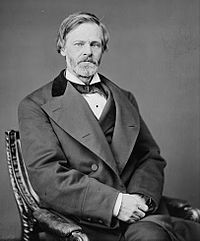
"Sen. John Sherman (R–OH), the principal author of the Sherman Antitrust Act."
https://en.wikipedia.org/wiki/Sherman...
https://www.ourdocuments.gov/doc.php?...
https://www.shrm.org/legalissues/fede...
http://www.linfo.org/sherman_txt.html
http://www.u-s-history.com/pages/h760...
On the Progressive Movement - http://www.u-s-history.com/pages/h106...
On Muckrakers - http://www.u-s-history.com/pages/h920...

"Sen. John Sherman (R–OH), the principal author of the Sherman Antitrust Act."
 Benjamin Tillman
Benjamin Tillman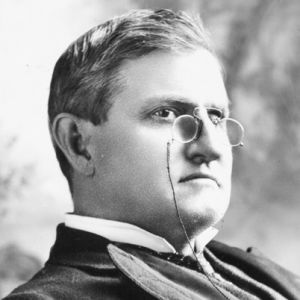
Benjamin Ryan Tillman (August 11, 1847 – July 3, 1918) was a politician of the Democratic Party who was Governor of South Carolina from 1890 to 1894, and a United States Senator from 1895 until his death in 1918. A white supremacist who often spoke out against blacks, Tillman led a paramilitary group of Red Shirts during South Carolina's violent 1876 election. On the floor of the U.S. Senate, he frequently ridiculed blacks, and boasted of having helped to kill them during that campaign.
In the 1880s, Tillman, a wealthy landowner, became dissatisfied with the Democratic leadership and led a movement of white farmers calling for reform. He was initially unsuccessful, though he was instrumental in the founding of Clemson University as an agricultural school. In 1890, Tillman took control of the state Democratic Party, and was elected governor. During his four years in office, 18 African Americans were lynched in South Carolina—the 1890s saw the most lynchings of any decade in South Carolina. Tillman tried to prevent lynchings, but spoke in support of the lynch mobs, stating his own willingness to lead one. In 1894, at the end of his second two-year term, he was elected to the U.S. Senate by vote of the state legislature.
Tillman was known as "Pitchfork Ben" because of his aggressive language, as when he threatened to use one to prod that "bag of beef", President Grover Cleveland. Considered a possible candidate for the Democratic nomination for president in 1896, Tillman lost any chance after giving a disastrous speech at the convention. He became known for his virulent oratory (especially against African Americans) but also as an effective legislator. The first federal campaign finance law, banning corporate contributions, is commonly called the Tillman Act. Tillman was repeatedly re-elected, serving in the Senate for the rest of his life. One of his legacies was South Carolina's 1895 constitution, which disenfranchised most of the black majority and ensured white rule for more than half a century.
From Britannica:
American Politician
Benjamin R. Tillman, byname Pitchfork Ben Tillman (born Aug. 11, 1847, Edgefield county, S.C., U.S.—died July 3, 1918, Washington, D.C.) outspoken U.S. populist politician who championed agrarian reform and white supremacy. Tillman served as governor of South Carolina (1890–94) and was a member of the U.S. Senate (1895–1918).
A farmer prior to his entry into politics, Tillman, a Democrat, emerged during the 1880s as a spokesman for poor rural whites in South Carolina in their conflict against both the ruling white aristocracy and the impoverished Negro population. The rise of Tillman marked the decline of the former Confederate general Wade Hampton as a political force in the state. Elected governor in 1890, Tillman translated his populist rhetoric into concrete reforms. He shifted the tax burden to the wealthy, improved public education, founded the agricultural college later to be known as Clemson University, and regulated the railroads. He also helped write the state constitution to disfranchise Negroes and circumvent the Fifteenth Amendment with a patchwork of Jim Crow laws (i.e., laws enforcing racial segregation). An unabashed bigot, he considered lynching an acceptable law-enforcement measure.
Elected to the U.S. Senate in 1894, Tillman served until his death, continuing to press for agrarian reform on the national level. He bitterly assailed Pres. Grover Cleveland for his hard-money policy, supporting instead the free-silver program of William Jennings Bryan. In most instances he opposed the administration of Pres. Theodore Roosevelt. In fact, the two became such bitter enemies that at one point the President barred Tillman from the White House. They put aside their differences long enough, however, to collaborate in securing passage of the Hepburn Act (1906), extending the Interstate Commerce Commission’s regulatory powers over the railroads. Tillman was floor leader for the bill. He generally supported Pres. Woodrow Wilson and, as chairman of the Senate Naval Affairs Committee, promoted the administration’s program to strengthen the Navy. His vituperative and often profane attacks on his political opponents earned him the nickname “Pitchfork Ben”; he once had a fistfight with his South Carolina colleague on the floor of the Senate.
Sources:
https://en.wikipedia.org/wiki/Benjami...
http://www.britannica.com/biography/B...
message 58:
by
Bentley, Group Founder, Leader, Chief
(last edited Apr 26, 2016 12:25PM)
(new)
-
rated it 4 stars
OK - < b >text< / b > just take out the spaces and replace the word text with Benjamin Tillman
That is it for bolding
Clean up your spacing - you have too much spacing in some of the places and for your links - just say
Sources: and you can then here
That is it for bolding
Clean up your spacing - you have too much spacing in some of the places and for your links - just say
Sources: and you can then here
 Bentley wrote: "OK - text just take out the spaces and replace the word text with Benjamin Tillman
Bentley wrote: "OK - text just take out the spaces and replace the word text with Benjamin TillmanThat is it for bolding
Clean up your spacing - you have too much spacing in some of the places and for your link..."
Got the bolding but not the image yet.
message 60:
by
Bentley, Group Founder, Leader, Chief
(last edited Apr 26, 2016 04:10PM)
(new)
-
rated it 4 stars
@ Helga
< img src="place the jpg file address here between the quotes and nothing else" / >
I ignore everything else about height and width - usually all jpeg and tiff files work
So take out all of the spaces aside from the one between img and src
See if we can get you to learn this.
< img src="place the jpg file address here between the quotes and nothing else" / >
I ignore everything else about height and width - usually all jpeg and tiff files work
So take out all of the spaces aside from the one between img and src
See if we can get you to learn this.
 Bentley wrote: "@ Helga
Bentley wrote: "@ Helga I ignore everything else about height and width - usually all jpeg and tiff files work
So take out all of the spaces aside from the one between img and src
See if we can get you to le..."
Got it now. Thanks alot.
 Charles Carroll
Charles Carroll
Charles Carroll was a Maryland delegate to the Continental Congress and a signer of the Declaration of Independence.
Born into a wealthy family, Charles Carroll became a member of the Continental Congress as the American Revolution loomed. Carroll missed the vote on independence but signed the final draft of the Declaration on Independence, becoming the only Catholic to do so. He was a member of the Maryland state Senate and the U.S. Senate (concurrently), finally retiring to private life in 1800.
Before his death in 1832, he was the last surviving signer of the Declaration of Independence.
Early Years
Charles Carroll was born in September 1737 into a prominent Annapolis, Maryland, family. He was educated at Jesuit colleges in Maryland and France before going on to study law in Paris and London. In 1765 he returned to Maryland an educated man to take the reins of the family estate (which was one of the largest in the American colonies). He also added "of Carrollton" to his name (he appears as "Charles Carroll of Carrollton" in certain sources) to distinguish himself from his father and cousins, all of whom had similar names.
Because he was a Catholic, Carroll was not allowed to participate in politics, practice law (despite years of study) or vote, but he became known in important circles in a roundabout way by writing various anti-tax/tariff tracts (essentially, early protestations against "taxation without representation") in the Maryland Gazette under the pseudonym "First Citizen."
The War Looms
With the Revolution gearing up, in 1774 Carroll found himself approached by Benjamin Franklin and Samuel Chase to help gain the support of the Canadian government for their cause. Carried out by all three men, the eventual mission was not a success, but two years later Carroll was appointed to the Continental Congress, where he was an influential member of the Board of War and an early advocate for armed resistance and the ultimate severing of governmental ties with England. (He was nominated again in 1780 but decided not to accept the post.)
Postwar Activities
Although Carroll was not present to vote on the issue of independence, he was present for the signing of the final Declaration of Independence. Soon after, he resigned from the Continental Congress to serve in the Maryland State Assembly, where he was part of the group that drafted Maryland's constitution.
In 1777, Carroll became a Maryland state senator, serving until 1800. In 1789 he was elected U.S. senator, and he served as both a state and U.S. senator until 1793. In 1800 he retired from politics to concentrate on business matters: managing his vast real estate holdings, expanding his interests in the westward canal system and later helping to establish the Baltimore & Ohio Railroad Company.
Charles Carroll, the only Roman Catholic to sign the Declaration of Independence, was also the last surviving signer, dying in Baltimore in 1832 at the age of 95. (Source: Biography.com)
More:
http://charlescarrollhouse.com
https://en.wikipedia.org/wiki/Charles...
http://www.adherents.com/people/pc/Ch...
http://www.newadvent.org/cathen/03379...
http://bioguide.congress.gov/scripts/...
https://youtu.be/oE8OuHsrYKg
(no image) Life of Charles Carroll of Carrollton by Lewis Leonard (no photo)
(no image) Charles Carroll of Carrollton by Thomas O'Brien Hanley (no photo)
(no image) Eulogy on Charles Carroll of Carrollton by John Sergeant (no photo)
(no image) Charles Carroll and the American Revolution by Milton Lomask (no photo)
(no image) Journal of Charles Carroll of Carrolton by Brantz Mayer (no photo)
 by Scott McDermott (no photo)
by Scott McDermott (no photo) by Lewis Alexander 1845-1926 Leonard (no photo)
by Lewis Alexander 1845-1926 Leonard (no photo) by
by
 Bradley J. Birzer
Bradley J. Birzer
 Peter Cooper
Peter Cooper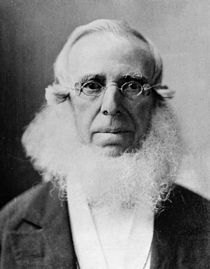
Peter Cooper (February 12, 1791 – April 4, 1883) was an American industrialist, inventor, philanthropist, and candidate for President of the United States. He designed and built the first American steam locomotive, the Tom Thumb,[1] and founded the Cooper Union for the Advancement of Science and Art in Manhattan, New York City.
Early life
Peter Cooper was born in New York City of Dutch, English and Huguenot descent, the fifth child of John Cooper, a Methodist hatmaker from Newburgh, New York. He worked as a coachmaker's apprentice, cabinet maker, hatmaker, brewer and grocer, and was throughout a tinkerer: he developed a cloth-shearing machine which he attempted to sell, as well as an endless chain he intended to be used to pull boats on the Erie Canal, which De Witt Clinton approved of, but which Cooper was unable to sell.
In 1821 Cooper purchased a glue factory on Sunfish Pond for $2,000 in Kips Bay, where he had access to raw materials from the nearby slaughterhouses, and ran it as a successful business for many years, producing a profit of $10,000 (equivalent to roughly $200,000 today) within 2 years, developing new ways to produce glues and cements, gelatin, isinglass and other products, and becoming the city's premier provider to tanners, manufacturers of paints, and dry-goods merchants. The effluent from his successful factory eventually polluted the pond to the extent that in 1839 it had to be drained and refilled.
Business career
Having been convinced that the proposed Baltimore and Ohio Railroad would drive up prices for land in Maryland, Cooper used his profits to buy 3,000 acres (12 km2) of land there in 1828 and began to develop them, draining swampland and flattening hills, during which he discovered iron ore on his property. Seeing the B&O as a natural market for iron rails to be made from his ore, he founded the Canton Iron Works in Baltimore, and when the railroad developed technical problems, he put together the Tom Thumb steam locomotive for them in 1830 from various old parts, including musket barrels, and some small-scale steam engines he had fiddled with back in New York. The engine was a rousing success, prompting investors to buy stock in B&O, which enabled the company to buy Cooper's iron rails, making him what would be his first fortune.
Cooper began operating an iron rolling mill in New York beginning in 1836, where he was the first to successfully use anthracite coal to puddle iron. Cooper later moved the mill to Trenton, New Jersey on the Delaware River to be closer to the sources of the raw materials the works needed. His son and son-in-law, Edward Cooper and Abram S. Hewitt, later expanded the Trenton facility into a giant complex employing 2,000 people, in which iron was taken from raw material to finished product.
Cooper also operated a successful glue factory in Gowanda, New York that produced glue for decades. A glue factory was originally started in association with the Gaensslen Tannery, there, in 1874, though the first construction of the glue factory's plant, originally owned by Richard Wilhelm and known as the Eastern Tanners Glue Company, began on May 5, 1904.[10] Gowanda, therefore, was known as America's glue capital.
Cooper owned a number of patents for his inventions, including some for the manufacture of gelatin, and he developed standards for its production. The patents were later sold to a cough syrup manufacturer who developed a pre-packaged form which his wife named "Jell-O".
Cooper later invested in real estate and insurance, and became one of the richest men in New York City. Despite this, he lived relatively simply in an age when the rich were indulging in more and more luxury. He dressed in simple, plain clothes, and limited his household to only two servants; when his wife bought an expensive and elaborate carriage, he returned it for a more sedate and cheaper one. Cooper remained in his home at Fourth Avenue and 28th Street even after the New York and Harlem Railroad established freight yards where cattle cars were parked practically outside his front door, although he did move to the more genteel Gramercy Park development in 1850.
In 1854, Cooper was one of five men who met at the house of Cyrus West Field in Gramercy Park to form the New York, Newfoundland and London Telegraph Company, and, in 1855, the American Telegraph Company, which bought up competitors and established extensive control over the expanding American network on the Atlantic Coast and in some Gulf coast states. He was among those supervising the laying of the first Transatlantic telegraph cable in 1858.
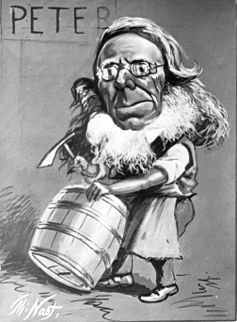
Cartoon of Peter Cooper by Thomas Nast
Political views and career
In 1840, Cooper became an alderman of New York City.
Prior to the Civil War, Cooper was active in the anti-slavery movement and promoted the application of Christian concepts to solve social injustice. He was a strong supporter of the Union cause during the war and an advocate of the government issue of paper money.
Influenced by the writings of Lydia Maria Child, Cooper became involved in the Indian reform movement, organizing the privately funded United States Indian Commission. This organization, whose members included William E. Dodge and Henry Ward Beecher, was dedicated to the protection and elevation of Native Americans in the United States and the elimination of warfare in the western territories.
Cooper's efforts led to the formation of the Board of Indian Commissioners, which oversaw Ulysses S. Grant's Peace Policy. Between 1870 and 1875, Cooper sponsored Indian delegations to Washington, D.C., New York City, and other Eastern cities. These delegations met with Indian rights advocates and addressed the public on United States Indian policy. Speakers included: Red Cloud, Little Raven, and Alfred B. Meacham and a delegation of Modoc and Klamath Indians.
Cooper was an ardent critic of the gold standard and the debt-based monetary system of bank currency. Throughout the depression from 1873–78, he said that usury was the foremost political problem of the day. He strongly advocated a credit-based, Government-issued currency of United States Notes. In 1883 his addresses, letters and articles on public affairs were compiled into a book, Ideas for a Science of Good Government.
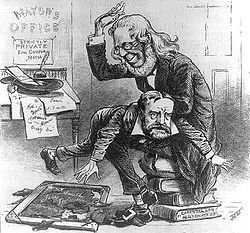
1879 Puck cartoon shows Cooper spanking his son Mayor Edward Cooper
Presidential candidacy
Cooper was encouraged to run in the 1876 presidential election for the Greenback Party without any hope of being elected. His running mate was Samuel Fenton Cary. The campaign cost more than $25,000. At the age of 85 years, Cooper is the oldest person ever nominated by any political party for President of the United States. The election was won by Rutherford Birchard Hayes of the Republican Party. Cooper was surpassed by another unsuccessful candidate: Samuel Jones Tilden of the Democratic Party.
Death and legacy
Cooper died on April 4, 1883 at the age of 92 and is buried in Green-Wood Cemetery in Brooklyn, New York.
Aside from Cooper Union, the Peter Cooper Village apartment complex in Manhattan; the Peter Cooper Elementary School in Ringwood, New Jersey; the Peter Cooper Station post office; and Cooper Square in Manhattan are named in his honor. (Source: Wikipedia)
More:
https://www.cooper.edu/about/history/...
http://www.ringwoodmanor.com/peo/ch/p...
http://www.biography.com/people/peter...
http://www.britannica.com/biography/P...
https://en.wikipedia.org/wiki/Stuyves...
(no image) Life and Character of Peter Cooper by Charles Edwards Lester (no photo)
 by Peter Cooper (no photo)
by Peter Cooper (no photo) by Rossiter Worthington Raymond (no photo)
by Rossiter Worthington Raymond (no photo) by Polly Guerin (no photo)
by Polly Guerin (no photo) by Ross Thomson (no photo)
by Ross Thomson (no photo) by Peter Cooper (no photo)
by Peter Cooper (no photo)
 Hepburn Act
Hepburn Act
The Hepburn Act is a 1906 United States federal law that gave the Interstate Commerce Commission (ICC) the power to set maximum railroad rates and extend its jurisdiction. This led to the discontinuation of free passes to loyal shippers. In addition, the ICC could view the railroads' financial records, a task simplified by standardized bookkeeping systems. For any railroad that resisted, the ICC's conditions would remain in effect until the outcome of legislation said otherwise. By the Hepburn Act, the ICC's authority was extended to cover bridges, terminals, ferries, railroad sleeping cars, express companies and oil pipelines.
Along with the Elkins Act of 1903, the Hepburn Act, named for its sponsor, eleven-term Republican William Peters Hepburn, was a subset of one of President Theodore Roosevelt's major goals: railroad regulation.
The final version was close to what Roosevelt had asked, and easily passed Congress with only three dissenting votes. The most important provision gave the ICC the power to replace existing rates with "just-and-reasonable" maximum rates, with the ICC to define what was just and reasonable. The Act made ICC orders binding; that is, the railroads had to either obey or contest the ICC orders in federal court. To speed the process, appeals from the district courts would go directly to the U.S. Supreme Court.
Anti-rebate provisions were toughened, free passes were outlawed, and the penalties for violation were increased. The ICC staff grew from 104 in 1890 to 178 in 1905, 330 in 1907, and 527 in 1909. Finally, the ICC gained the power to prescribe a uniform system of accounting, require standardized reports, and inspect railroad accounts.
The limitation on railroad rates depreciated the value of railroad securities, a factor in causing the Panic of 1907.
Scholars consider the Hepburn Act the most important piece of legislation regarding railroads in the first half of the 20th century. Economists and historians debate whether it crippled the railroads, giving so much advantage to the shippers that a giant unregulated trucking industry—undreamed of in 1906—took away their business. (Source: Wikipedia)
More:
https://www.archives.gov/legislative/...
http://www.theodorerooseveltcenter.or...
https://dwkcommentaries.com/2014/08/2...
http://www.u-s-history.com/pages/h921...
http://commercial.laws.com/hepburn-act
http://study.com/academy/lesson/the-h...
http://www.encyclopedia.com/topic/Hep...
(no image)Enterprise Denied: Origins of the Decline of American Railroads, 1897-1917 by Albro Martin (no photo)
(no image)Railroads in the Age of Regulation, 1900-1980 by Keith L. Bryant Jr. (no photo)
 by Richard D. Stone (no photo)
by Richard D. Stone (no photo) by John J. Cooper (no photo)
by John J. Cooper (no photo) by Marc Allen Eisner (no photo)
by Marc Allen Eisner (no photo) by Gabriel Kolko (no photo)
by Gabriel Kolko (no photo) by
by
 Theodore Roosevelt
Theodore Roosevelt
 William Peters Hepburn
William Peters Hepburn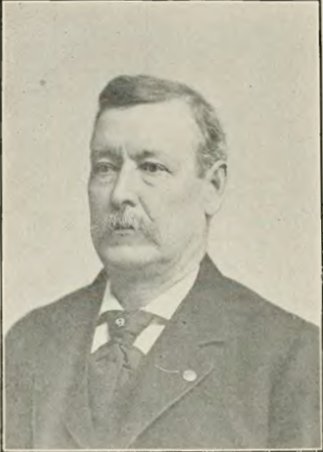
William Peters Hepburn (November 4, 1833 – February 7, 1916)–lawyer and U.S. representative—was born in Wellsville, Ohio. His father, John S. Hepburn, a West Point-educated artillery officer, died in New Orleans of cholera nearly six months before his son's birth. His mother, Ann Fairfax (Catlett) Hepburn, a schoolteacher, married George S. Hampton, who moved the family to Iowa in 1841 after his shipping business failed. After attempting to farm for two years, the family moved to Iowa City in 1843. There William entered school for the first time, attending irregularly for five years while working at a variety of jobs. He credited his apprenticeship at the Iowa City Republican, a Whig newspaper, as his greatest education. His fascination with politics inspired him to study law under William Penn Clarke in 1853. After passing the Illinois bar in 1854, he began practicing law in Chicago. The following year he married Melvina A. Morsman, and the couple eventually had five children. Shortly after their marriage, the couple moved to Marshalltown, Iowa, where William started his own law firm.
Hepburn began his political career by attending the first Iowa Republican convention in 1856. He gained political influence and was elected prosecuting attorney of Marshall County. When the Republican Party took control of Iowa's Sixth General Assembly in 1856, Hepburn's loyalty was rewarded with an appointment to the office of assistant clerk, and he served as chief clerk in 1858. Later that year Hepburn was elected district attorney of the Eleventh District. He remained active in the Republican Party, serving as a delegate to the Republican National Convention in 1860.
The outbreak of the Civil War left Hepburn torn between remaining at home and joining the war effort. After the Union's defeat at Bull Run, he helped organize Company B of the Second Iowa Volunteer Cavalry, which elected him as captain. He advanced to the ranks of major and eventually lieutenant colonel, and gained recognition for his valiant service at the Battle of Corinth. Following the war, Hepburn moved to Memphis and opened a law firm, but the effort was short-lived. In 1867 he moved to Clarinda, Iowa, to serve as editor and partial owner of the Page County Herald. He later opened a law office, which handled cases for the Burlington Railroad after it extended its line through Council Bluffs.
Politically, in the 1870s Hepburn backed the progressive wing of the Republican Party, supporting Horace Greeley for president. In 1880 he moved into the national political arena when he won the Republican nomination for the Eighth District seat in the U.S. House of Representatives. He defeated the incumbent William Sapp on the 385th ballot of the state Republican convention.
During his first six years in Washington, Hepburn supported the payment of veterans' pensions, criticized pork projects of the River and Harbor Bill, and lobbied for temperance reform. In 1886 Albert R. Anderson defeated Hepburn for reelection by focusing on the tariff and railroad regulation. Hepburn returned to his law practice in Clarinda, but remained politically active. In the Harrison administration, he served on the Pacific Railroad Commission and as solicitor of the treasury.
In 1892 Hepburn was reelected to the U.S. House of Representatives from Iowa's Eighth District and gradually rose to national political prominence. In 1895 he was appointed to chair the House Committee on Interstate and Foreign Commerce. His work with President Theodore Roosevelt on the Hepburn Act was the culmination of his work on transportation issues. The Hepburn Act was also a centerpiece of President Roosevelt's public policies, which fostered social change and progressive reforms. When the law passed, it broadened the power of the Interstate Commerce Commission (ICC) to set maximum rates for shippers, increased the size of the ICC, outlawed pooling and rebates, set standardized accounting practices for all common carriers, and broadened the definition of common carriers to include pipelines, bridges, and terminals, bringing them under the control of the ICC.
Hepburn was involved in and outspoken on other progressive legislation. He coauthored the Pure Food and Drug Act. Its passage in 1906 inspired Roosevelt to declare that this would be one of the most productive Congresses in history. Hepburn also fought to reduce the power of the Speaker of the House and pushed for the annexation of Hawaii and the construction of the Panama Canal. He concurred with the Republican Party's opposition to the expansion of trade unions. As a reward for his partisanship, he chaired the Republican caucus from 1903 to 1909.
In 1908 Hepburn lost his bid for reelection, ending his political career. He remained in Washington for a couple of years, opening another law office, but he eventually returned to Clarinda, where he died in 1916. The Republican Party enjoyed the support of an impressive debater, speaker, and politician who was a leader in Iowa politics and a loyal Republican for 60 years. Newspapers across the country ran obituaries for the great Republican from Iowa. (Source: The University of Iowa)
More:
http://www.infoplease.com/encyclopedi...
https://archive.org/stream/wmpetershe...
http://gw.geneanet.org/tdowling?lang=...
http://history.house.gov/People/Detai...
https://en.wikipedia.org/wiki/William...
https://en.wikipedia.org/wiki/William...
(no image)William Peters Hepburn by John Ely Briggs (no photo)
 by Jesse Russell (no photo)
by Jesse Russell (no photo) by Benjamin F. Gue (no photo)
by Benjamin F. Gue (no photo) by Joseph Frazier Wall (no photo)
by Joseph Frazier Wall (no photo) by Johnson Brigham (no photo)
by Johnson Brigham (no photo)
 William Randolph Hearst
William Randolph Hearst
William Randolph Hearst, (born April 29, 1863, San Francisco, California, U.S.—died August 14, 1951, Beverly Hills, California)American newspaper publisher who built up the nation’s largest newspaper chain and whose methods profoundly influenced American journalism.
Hearst was the only son of George Hearst, a gold-mine owner and U.S. senator from California (1886–91). The young Hearst attended Harvard College for two years before being expelled for antics ranging from sponsoring massive beer parties in Harvard Square to sending chamber pots to his professors (their images were depicted within the bowls). In 1887 he took control of the struggling San Francisco Examiner, which his father had bought in 1880 for political reasons. Hearst remade the paper into a blend of reformist investigative reporting and lurid sensationalism, and within two years it was showing a profit. He then entered the New York City newspaper market in 1895 by purchasing the theretofore unsuccessful New York Morning Journal. He hired such able writers as Stephen Crane and Julian Hawthorne and raided the New York World for some of Joseph Pulitzer’s best men, notably Richard F. Outcault, who drew the Yellow Kid cartoons. The New York Journal (afterward New York Journal-American) soon attained an unprecedented circulation as a result of its use of many illustrations, colour magazine sections, and glaring headlines; its sensational articles on crime and pseudoscientific topics; its bellicosity in foreign affairs; and its reduced price of one cent. Hearst’s Journal and Pulitzer’s World became involved in a series of fierce circulation wars, and these newspapers’ use of sensationalistic reporting and frenzied promotional schemes brought New York City journalism to a boil. Competition between the two papers, including rival Yellow Kid cartoons, soon gave rise to the term yellow journalism.
The Journal excoriated Great Britain in the Venezuela-British Guiana border dispute (from 1895) and then demanded (1897–98) war between the United States and Spain. Through dishonest and exaggerated reportage, Hearst’s newspapers whipped up public sentiment against Spain so much that they actually helped cause the Spanish-American War of 1898. Hearst supported William Jennings Bryan in the presidential campaign of 1896 and again in 1900, when he assailed President William McKinley as a tool of the trusts (the biggest companies in the United States).
While serving rather inactively in the U.S. House of Representatives (1903–07), Hearst received considerable support for the Democratic presidential nomination in 1904 and, running on an anti-Tammany Hall ticket, came within 3,000 votes of winning the 1905 election for mayor of New York City. In 1906, despite (or perhaps because of) his having turned to Tammany for support, he lost to Charles Evans Hughes for governor of New York, and in 1909 he suffered a worse defeat in the New York City mayoral election. Rebuffed in his political ambitions, Hearst continued to vilify the British Empire, opposed U.S. entry into World War I, and maligned the League of Nations and the World Court.
By 1925 Hearst had established or acquired newspapers in every section of the United States, as well as several magazines. He also published books of fiction and produced motion pictures featuring the actress Marion Davies, his mistress for more than 30 years. In the 1920s he built a grandiose castle on a 240,000-acre (97,000-hectare) ranch in San Simeon, California, and he furnished this residential complex with a vast collection of antiques and art objects that he had bought in Europe. At the peak of his fortune in 1935, he owned 28 major newspapers and 18 magazines, along with several radio stations, movie companies, and news services. But his vast personal extravagances and the Great Depression of the 1930s soon seriously weakened his financial position, and he had to sell faltering newspapers or consolidate them with stronger units. In 1937 he was forced to begin selling off some of his art collection, and by 1940 he had lost personal control of the vast communications empire that he had built. He lived the last years of his life in virtual seclusion. Hearst’s life was the basis for the movie Citizen Kane (1941).
At the beginning of the 21st century, the family-owned Hearst Corporation was still one of the largest media companies in the United States, with interests in magazines, broadcasting, and cartoon and feature syndicates.
(Source: Encyclopedia Britannica)
More:
https://en.wikipedia.org/wiki/William...
http://www.biography.com/people/willi...
http://www.history.com/topics/william...
http://www.zpub.com/sf/history/willh....
http://hearstcastle.org/history-behin...
http://www.notablebiographies.com/Gi-...
http://www.hearstfdn.org/about/willia...
http://www.encyclopedia.com/topic/Wil...
 by W. Joseph Campbell (no photo)
by W. Joseph Campbell (no photo) by Ben Procter (no photo)
by Ben Procter (no photo) by Oliver Carlson (no photo)
by Oliver Carlson (no photo) by Marion Davies (no photo)
by Marion Davies (no photo) by Daniel Alef (no photo)
by Daniel Alef (no photo) by Kenneth Whyte (no photo)
by Kenneth Whyte (no photo) by
by
 David Nasaw
David Nasaw
 Benjamin Ryan Tillman Jr.
Benjamin Ryan Tillman Jr.
Benjamin R. Tillman, byname Pitchfork Ben Tillman (born Aug. 11, 1847, Edgefield county, S.C., U.S.—died July 3, 1918, Washington, D.C.) outspoken U.S. populist politician who championed agrarian reform and white supremacy. Tillman served as governor of South Carolina (1890–94) and was a member of the U.S. Senate (1895–1918).
A farmer prior to his entry into politics, Tillman, a Democrat, emerged during the 1880s as a spokesman for poor rural whites in South Carolina in their conflict against both the ruling white aristocracy and the impoverished Negro population. The rise of Tillman marked the decline of the former Confederate general Wade Hampton as a political force in the state. Elected governor in 1890, Tillman translated his populist rhetoric into concrete reforms. He shifted the tax burden to the wealthy, improved public education, founded the agricultural college later to be known as Clemson University, and regulated the railroads. He also helped write the state constitution to disfranchise Negroes and circumvent the Fifteenth Amendment with a patchwork of Jim Crow laws (i.e., laws enforcing racial segregation). An unabashed bigot, he considered lynching an acceptable law-enforcement measure.
Elected to the U.S. Senate in 1894, Tillman served until his death, continuing to press for agrarian reform on the national level. He bitterly assailed Pres. Grover Cleveland for his hard-money policy, supporting instead the free-silver program of William Jennings Bryan. In most instances he opposed the administration of Pres. Theodore Roosevelt. In fact, the two became such bitter enemies that at one point the President barred Tillman from the White House. They put aside their differences long enough, however, to collaborate in securing passage of the Hepburn Act (1906), extending the Interstate Commerce Commission’s regulatory powers over the railroads. Tillman was floor leader for the bill. He generally supported Pres. Woodrow Wilson and, as chairman of the Senate Naval Affairs Committee, promoted the administration’s program to strengthen the Navy. His vituperative and often profane attacks on his political opponents earned him the nickname “Pitchfork Ben”; he once had a fistfight with his South Carolina colleague on the floor of the Senate. (Source: Encyclopedia Britannica)
More:
https://en.wikipedia.org/wiki/Benjami...
http://www.biography.com/people/benja...
http://projects.vassar.edu/1896/tillm...
http://www.charlestoncitypaper.com/ch...
http://www.sciway.net/hist/governors/...
http://historymatters.gmu.edu/d/55/
http://downwithtillman.com/
http://www.senate.gov/artandhistory/h...
http://www.researchonline.net/sccw/bi...
(no image)The History Of South Carolina by Mary C. Simms Oliphant (no photo)
 by Stephen Kantrowitz (no photo)
by Stephen Kantrowitz (no photo) by Francis Butler Simkins (no photo)
by Francis Butler Simkins (no photo) by Rayford W. Logan (no photo)
by Rayford W. Logan (no photo) by Bryant Simon (no photo)
by Bryant Simon (no photo)
 John Kean of New Jersey
John Kean of New Jersey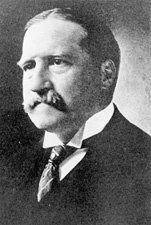
KEAN, John, (brother of Hamilton Fish Kean, great-grandson of John Kean [1756-1795], and uncle of Robert Winthrop Kean), a Representative and a Senator from New Jersey; born at ‘Ursino,’ near Elizabeth, N.J., December 4, 1852; studied in private schools and attended Yale College; graduated from the Columbia Law School, New York City, in 1875; admitted to the New Jersey bar in 1877, but did not engage in extensive practice; engaged in banking and interested in manufacturing; elected as a Republican to the Forty-eighth Congress (March 4, 1883-March 3, 1885); unsuccessful candidate for reelection in 1884; elected to the Fiftieth Congress (March 4, 1887-March 3, 1889); unsuccessful candidate for reelection in 1888; unsuccessful Republican candidate for Governor in 1892; member of the committee to revise the judiciary system of New Jersey; elected to the United States Senate in 1899; reelected in 1905, and served from March 4, 1899, to March 3, 1911; chairman, Committee on the Geological Survey (Fifty-seventh Congress), Committee to Audit and Control the Contingent Expenses (Fifty-eighth through Sixty-first Congresses); engaged in banking in Elizabeth, N.J.; died in Ursino, N.J., on November 4, 1914; interment in Evergreen Cemetery, Elizabeth, N.J.
(Source:Biographical Directory of the United States Congress)
More:
https://en.wikipedia.org/wiki/John_Ke...
http://politicalgraveyard.com/bio/kau...
http://query.nytimes.com/mem/archive-...
https://en.wikipedia.org/wiki/Liberty...
https://www.govtrack.us/congress/memb...
http://www.kean.edu/libertyhall/about...
http://www.nj.com/insidejersey/index....
http://www.findagrave.com/cgi-bin/fg....
http://bigoldhouses.blogspot.hr/2014/...
 by Keith T. Poole (no photo)
by Keith T. Poole (no photo) by Kenneth C. Martis (no photo)
by Kenneth C. Martis (no photo) by Lawrence S. Rowland (no photo)
by Lawrence S. Rowland (no photo) by William Edgar Sackett (no info)
by William Edgar Sackett (no info) by Barbara G. Salmore ( no photo)
by Barbara G. Salmore ( no photo)
 Thomas Brackett Reed
Thomas Brackett Reed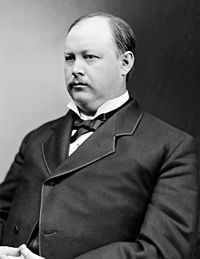
Thomas B. Reed, (born Oct. 18, 1839, Portland, Maine, U.S.—died Dec. 7, 1902, Washington, D.C.) vigorous U.S. Republican Party leader who, as speaker of the U.S. House of Representatives (1889–91, 1895–99), introduced significant procedural changes (the Reed Rules) that helped ensure legislative control by the majority party in Congress.
After he was admitted to the bar in 1865, Reed began his law practice in Portland and was elected to the Maine House of Representatives in 1868 and to the state Senate two years later. He was elected to Congress on the Republican ticket in 1877 and served continuously until the end of the century. In 1882 he was appointed to the House Committee on Rules, and when the Republicans regained control of the House in 1889, Reed was elected speaker. As a strong speaker, he arranged for the control of the Rules Committee by the majority party in Congress.
The Reed Rules, adopted in February 1890, provided that every member present in the House must vote unless financially interested in a measure; that members present and not voting be counted for a quorum; and that no dilatory motions be entertained by the chair. Reed claimed these innovations enhanced legislative efficiency and helped ensure democratic (majority) control of the House; many thought they made a major contribution to the U.S. political system by establishing the principle of party responsibility. His dictatorial methods were bitterly attacked by the opposition, however, who called him Czar Reed. Nevertheless, the Reed Rules and methods were adopted by the Democratic leadership in 1891–95, and the power of the Rules Committee was increased.
Though denied the 1896 presidential nomination he had sought, Reed nonetheless supported the domestic programs of Pres. William McKinley and exercised a powerful influence in guiding bills through Congress. In 1899, however, he broke with the Republican administration over what he considered its expansionist policy toward Cuba and Hawaii. He resigned from the House in protest and retired to New York to practice law and to write. (Source: Encyclopedia Britannica)
More:
https://en.wikipedia.org/wiki/Thomas_...
https://en.wikipedia.org/wiki/Thomas_...
http://www.npr.org/2011/05/29/1366892...
http://www.biography.com/people/thoma...
http://history.house.gov/Historical-H...
http://blog.oup.com/2015/03/thomas-re...
http://www.nytimes.com/2011/07/31/boo...
http://www.encyclopedia.com/topic/Tho...
http://leg.wa.gov/LawsAndAgencyRules/...
(no image)Thomas B. Reed, Parliamentarian by William Alexander Robinson (no photo)
(no image)From Hayes to McKinley by H. Wayne Morgan (no photo)
 by Samuel W 1851-1923 McCall (no photo)
by Samuel W 1851-1923 McCall (no photo) by James Grant (no photo)
by James Grant (no photo) by Arthur Wallace Dunn (no photo)
by Arthur Wallace Dunn (no photo) by
by
 Barbara W. Tuchman
Barbara W. Tuchman by
by
 Mark Twain
Mark Twain
 Jay Gould
Jay Gould
Jason "Jay" Gould (May 27, 1836 – December 2, 1892) was a leading American railroad developer and speculator. He has been referred to as one of the ruthless robber barons of the Gilded Age, whose success at business made him the ninth richest U.S. citizen in history. Some modern historians like Walter R. Borneman working from primary sources have discounted his negative portrayal.
Early Career
His principal was credited as getting him a job working as a bookkeeper for a blacksmith. A year later the blacksmith offered him half interest in the blacksmith shop, which he sold to his father during the early part of 1854. Gould devoted himself to private study, emphasizing surveying and mathematics. In 1854, Gould surveyed and created maps of the Ulster County, New York area. In 1856 he published History of Delaware County, and Border Wars of New York, which he had spent several years writing.
In 1856, Gould entered a partnership with Zadock Pratt to create a tanning business in Pennsylvania in what would become Gouldsboro. Eventually, he bought out Pratt, who retired. In 1856, Gould entered another partnership with Charles Mortimer Leupp, a son-in-law of Gideon Lee, and one of the leading leather merchants in the United States at the time. Leupp and Gould was a successful partnership until the Panic of 1857. Leupp lost all his money, while Gould took advantage of the opportunity of the depreciation of property value and bought up former partnership properties for himself.
After the death of Charles Leupp, the Gouldsboro Tannery became a disputed property. Leupp's brother-in-law, David W. Lee, who was also a partner in Leupp and Gould, took armed control of the tannery. He believed that Gould had cheated the Leupp and Lee families in the collapse of the business. Eventually, Gould took physical possession, but was later forced to sell his shares in the company to Lee's brother.
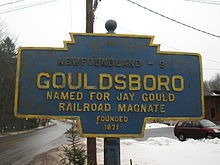
Keystone Marker for Gouldsboro, named after Jay Gould.
Railroad investing
In 1859 Gould began speculative investing by buying stock in small railways. Gould's father-in-law Daniel S. Miller was credited with introducing the younger man to the railroad industry, when he suggested that Gould help him save his investment in the Rutland and Washington Railroad in the Panic of 1857. Gould purchased stock for 10 cents on the dollar, which left him in control of the company.
Through the Civil War era, he did more speculation on railroad stocks in New York City. In 1863 he was appointed manager of the Rensselaer and Saratoga Railroad.
The Erie Railroad encountered financial troubles in the 1850s, despite receiving loans from financiers Cornelius Vanderbilt and Daniel Drew. The Erie entered receivership in 1859 and was reorganized as the Erie Railway. Jay Gould, Drew and James Fisk engaged in stock manipulations known as the Erie War, with the result that in the summer of 1868 Drew, Fisk, and Vanderbilt lost control of the Erie, while Gould became its president.
Tweed Ring
It was during the same period that Gould and Fisk became involved with Tammany Hall, the New York City political ring. They made Boss Tweed a director of the Erie Railroad, and Tweed, in return, arranged favorable legislation for them. Tweed and Gould became the subjects of political cartoons by Thomas Nast in 1869. In October 1871, when Tweed was held on $1 million bail, Gould was the chief bondsman.
Black Friday
In August 1869, Gould and Fisk began to buy gold in an attempt to corner the market, hoping that the increase in the price of gold would increase the price of wheat such that western farmers would sell, causing a great amount of shipping of bread stuffs eastward, increasing freight business for the Erie railroad. During this time, Gould used contacts with President Ulysses S. Grant's brother-in-law, Abel Corbin, to try to influence the president and his Secretary General Horace Porter. These speculations in gold culminated in the panic of Black Friday, on September 24, 1869, when the premium over face value on a gold Double Eagle fell from 62 percent to 35 percent. Gould made a small profit from this operation, but lost it to subsequent lawsuits. The gold corner established Gould's reputation in the press as an all-powerful figure who could drive the market up and down at will.
Lord Gordon-Gordon
In 1873 Gould attempted to take control of the Erie Railroad by recruiting foreign investments from Lord Gordon-Gordon, whom he believed was a cousin of the wealthy Campbells looking to buy land for immigrants. He bribed Gordon-Gordon with $1 million in stock. But Gordon-Gordon was an impostor and cashed the stock immediately. Gould sued Gordon-Gordon; the case went to trial in March 1873. In court, Gordon-Gordon gave the names of the Europeans whom he claimed to represent, and was granted bail while the references were checked. He fled to Canada, where he convinced authorities that the charges against him were false.
After failing to convince or force Canadian authorities to hand over Gordon-Gordon, Gould and his associates, which included two future governors of Minnesota and three future members of Congress (Loren Fletcher, John Gilfillan, and Eugene McLanahan Wilson) attempted to kidnap him. The group snatched him successfully, but they were stopped and arrested by the North-West Mounted Police before they could return to the United States. The kidnappers were put in prison and refused bail.
This led to an international incident between the United States and Canada. Upon learning that the kidnappers were not given bail, Governor Horace Austin of Minnesota demanded their return; he put the local militia on a state of full readiness. Thousands of Minnesotans volunteered for a full military invasion of Canada. After negotiations, the Canadian authorities released the kidnappers on bail. The incident resulted in Gould losing any possibility of taking control of Erie Railroad.
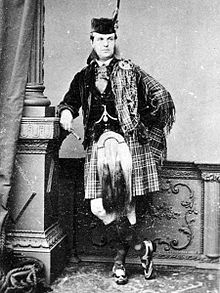
Lord Gordon-Gordon
Western railroads
After being forced out of the Erie Railroad, Gould started to build up a system of railroads in the Midwest and West. He took control of the Union Pacific in 1873 when its stock was depressed by the Panic of 1873 and built a viable railroad that depended on shipments by local farmers and ranchers. Gould immersed himself in every operational and financial detail of the UP system. He built an encyclopedic knowledge, then acted decisively to shape its destiny. "He revised its financial structure, waged its competitive struggles, captained its political battles, revamped its administration, formulated its rate policies, and promoted the development of resources along its lines." After Gould's death, the Union Pacific slipped and declared bankruptcy during the Panic of 1893.
By 1879, Gould gained control of three more important western railroads, including the Missouri Pacific Railroad. He controlled 10,000 miles (16,000 km) of railway, about one-ninth of the length of rail in the United States at that time, and, by 1882, he had controlling interest in 15 percent of the country's trackage. Because the railroads were making profits and had control of rate setting, his wealth increased dramatically. When Gould withdrew from management of the Union Pacific in 1883 amidst political controversy over its debts to the federal government, he realized a large profit for himself. He obtained a controlling interest in the Western Union telegraph company, and, after 1881, in the elevated railways in New York City.

Cartoon depicting Wall Street as "Jay Gould's Private Bowling Alley"
Death
Gould died of tuberculosis on December 2, 1892, and was interred in the Woodlawn Cemetery, The Bronx, New York. His fortune was conservatively estimated at $72 million for tax purposes, which he willed in its entirety to his family.
At the time of his death, Gould was a benefactor in the reconstruction of the Reformed Church of Roxbury, New York, now known as the Jay Gould Memorial Reformed Church. It is located within the Main Street Historic District and listed on the National Register of Historic Places in 1988. The family mausoleum was designed by Francis O'Hara. (Source: Wikipedia)
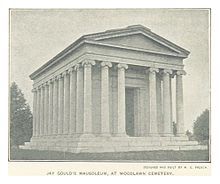
The mausoleum of Jay Gould (Source: Wikipedia)
More:
http://www.notablebiographies.com/Gi-...
http://www.biography.com/people/jay-g...
http://www.u-s-history.com/pages/h866...
http://www.britannica.com/biography/J...
http://history1800s.about.com/od/robb...
(no image) Jay Gould: The Story of a Fortune by Robert Warshow (no photo)
 by Daniel Alef (no photo)
by Daniel Alef (no photo) by Charles R. Morris (no photo)
by Charles R. Morris (no photo) by
by
 Maury Klein
Maury Klein by
by
 Stephen Jay Gould
Stephen Jay Gould by
by
 Edward J. Renehan Jr.
Edward J. Renehan Jr.
 Cornelius Vanderbilt
Cornelius Vanderbilt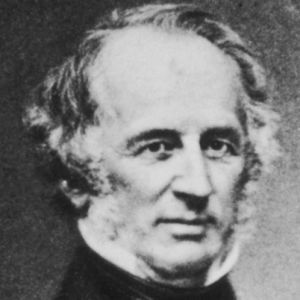
Cornelius Vanderbilt, (born May 27, 1794, Port Richmond, Staten Island, New York, U.S.—died January 4, 1877, New York, New York) American shipping and railroad magnate who acquired a personal fortune of more than $100 million.
The son of an impoverished farmer and boatman, Vanderbilt quit school at age 11 to work on the waterfront. In 1810 he purchased his first boat with money borrowed from his parents. He used the boat to ferry passengers between Staten Island and New York City. Then, during the War of 1812, he enlarged his operation to a small fleet, with which he supplied government outposts around the city.
Vanderbilt expanded his ferry operation still further following the war, but in 1818 he sold all his boats and went to work for Thomas Gibbons as steamship captain. While in Gibbons’s employ (1818–29), Vanderbilt learned the steamship business and acquired the capital that he used in 1829 to start his own steamship company.
During the next decade, Vanderbilt gained control of the traffic on the Hudson River by cutting fares and offering unprecedented luxury on his ships. His hard-pressed competitors finally paid him handsomely in return for Vanderbilt’s agreement to move his operation. He then concentrated on the northeastern seaboard, offering transportation from Long Island to Providence and Boston. By 1846 the Commodore was a millionaire.
The following year, he formed a company to transport passengers and goods from New York City and New Orleans to San Francisco via Nicaragua. With the enormous demand for passage to the West Coast brought about by the 1849 gold rush, Vanderbilt’s Accessory Transit Company proved a huge success. He quit the business only after his competitors—whom he had nearly ruined—agreed to pay him $40,000 (later it rose to $56,000) a month to abandon his operation.
By the 1850s he had turned his attention to railroads, buying up so much stock in the New York and Harlem Railroad that by 1863 he owned the line. He later acquired the Hudson River Railroad and the New York Central Railroad and consolidated them in 1869. When he added the Lake Shore and Michigan Southern Railroad in 1873, Vanderbilt was able to offer the first rail service from New York City to Chicago.
During the last years of his life, Vanderbilt ordered the construction of Grand Central Depot (the forerunner of Grand Central Terminal) in New York City, a project that gave jobs to thousands who had become unemployed during the Panic of 1873. Although never interested in philanthropy while acquiring the bulk of his huge fortune, later in his life he did give $1 million to Central University in Nashville, Tennessee. (later Vanderbilt University). In his will he left $90 million to his son William Henry, $7.5 million to William’s four sons, and—consistent with his lifelong contempt for women—the relatively small remainder to his second wife and his eight daughters. (Source: Britannica/Cornelius Vanderbilt)
More:
https://en.wikipedia.org/wiki/Corneli...
http://www.history.com/topics/corneli...
http://www.biography.com/people/corne...
http://www.newnetherlandinstitute.org...
http://www.library.vanderbilt.edu/spe...
http://www.encyclopedia.com/topic/Cor...
http://www.american-rails.com/corneli...
(no image) Cornelius Vanderbilt and the Railroad Industry by Lewis K. Parker (no photo)
 by T.J. Stiles (no photo)
by T.J. Stiles (no photo) by Daniel Alef (no photo)
by Daniel Alef (no photo) by Jeffrey L. Rodengen (no photo)
by Jeffrey L. Rodengen (no photo) by Charles River Editors (no photo)
by Charles River Editors (no photo) by Adam Calvert (no photo)
by Adam Calvert (no photo) by
by
 Edward J. Renehan Jr.
Edward J. Renehan Jr. by
by
 Stephen Dando-Collins
Stephen Dando-Collins
 Pure Food and Drug Act
Pure Food and Drug Act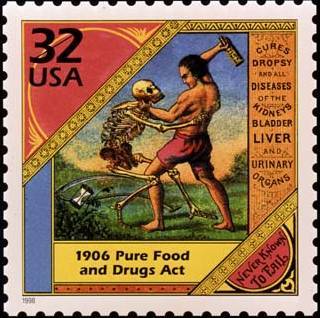
The Pure Food and Drug Act of 1906 was the first of a series of significant consumer protection laws enacted by Congress in the 20th century and led to the creation of the Food and Drug Administration. Its main purpose was to ban foreign and interstate traffic in adulterated or mislabeled food and drug products, and it directed the U.S. Bureau of Chemistry to inspect products and refer offenders to prosecutors. It required that active ingredients be placed on the label of a drug’s packaging and that drugs could not fall below purity levels established by the United States Pharmacopeia or the National Formulary. The Jungle by Upton Sinclair was an inspirational piece that kept the public's attention on the important issue of unsanitary meat processing plants that later led to food inspection legislation.
The Pure Food and Drug Act of 1906 was a key piece of Progressive Era legislation, signed by President Theodore Roosevelt on the same day as the Federal Meat Inspection Act. Enforcement of the Pure Food and Drug Act was assigned to the Bureau of Chemistry in the U.S. Department of Agriculture which was renamed the U.S. Food and Drug Administration (FDA) in 1930. The Meat Inspection Act was assigned to what is now known as the Food Safety and Inspection Service that remains in the U.S. Department of Agriculture. The first federal law regulating foods and drugs, the 1906 Act's reach was limited to foods and drugs moving in interstate commerce. Although the law drew upon many precedents, provisions, and legal experiments pioneered in individual states, the federal law defined "misbranding" and "adulteration" for the first time and prescribed penalties for each. The law recognized the U.S. Pharmacopeia and the National Formulary as standards authorities for drugs, but made no similar provision for federal food standards. The law was principally a "truth in labeling" law designed to raise standards in the food and drug industries and protect the reputations and pocketbooks of honest businessmen.
Under the law, drug labels, for example, had to list any of 10 ingredients that were deemed "addictive" and/or "dangerous" on the product label if they were present, and could not list them if they were not present. Alcohol, morphine, opium, and cannabis were all included on the list of these "addictive" and/or "dangerous" drugs. The law also established a federal cadre of food and drug inspectors that one Southern opponent of the legislation criticized as "a Trojan horse with a bellyful of inspectors and other employees." Penalties under the law were modest, but an under-appreciated provision of the Act proved more powerful than monetary penalties. Goods found in violation of the law were subject to seizure and destruction at the expense of the manufacturer. That, combined with a legal requirement that all convictions be published as Notices of Judgment, proved to be important tools in the enforcement of the statute and had a deterrent effect upon would-be violators. Deficiencies in this original statute, which had become noticeable by the 1920s, led to the replacement of the 1906 statute with the Federal Food, Drug, and Cosmetic Act, which, was enacted in 1938 and signed by President Franklin Roosevelt. The 1938 Food, Drug, and Cosmetic Act, along with its numerous amendments, remains the statutory basis for federal regulation of all foods, drugs, biological products, cosmetics, medical devices, tobacco, and radiation-emitting devices by the U.S. Food and Drug Administration.
It took 27 years to pass the 1906 statute, during which time the public was made aware of many problems with foods and drugs in the U.S. Muckraking journalists, such as Samuel Hopkins Adams, targeted the patent medicine industry with its high-alcoholic content patent medicines, soothing syrups for infants with opium derivatives, and "red clauses" in newspaper contracts providing that patent medicine ads (upon which most newspapers of the time were dependent) would be withdrawn if the paper expressed support for food and drug regulatory legislation. The Chief Chemist of the Bureau of Chemistry, Dr. Harvey Washington Wiley, captured the country's attention with his hygienic table studies, which began with a modest Congressional appropriation in 1902. The goal of the table trial was to study the human effects of common preservatives used in foods during a period of rapid changes in the food supply brought about by the need to feed cities and support an industrializing nation increasingly dependent on immigrant labor. Wiley recruited young men to eat all their meals at a common table as he added increased "doses" of preservatives including borax, benzoate, formaldehyde, sulfites, and salicylates. The table trials captured the nation's fancy and were soon dubbed "The Poison Squad" by newspapers covering the story. The men soon adopted the motto "Only the Brave dare eat the fare" and at times the publicity given to the trials became a burden. Though many results of the trial came to be in dispute, there was no doubt that formaldehyde was dangerous and it disappeared quickly as a preservative. Wiley himself felt that he had found adverse effects from large doses of each of the preservatives and the public seemed to agree with Wiley. In many cases, most particularly with ketchup and other condiments, the use of preservatives was often used to disguise insanitary production practices. Although the law itself did not proscribe the use of some of these preservatives, consumers increasingly turned away from many products with known preservatives.
The 1906 Act paved the way for the eventual creation of the Food and Drug Administration (FDA) and is generally considered to be that agency's founding date, though the agency existed before the law was passed and was not named FDA until later. "While the Food and Drug act remains a foundational law of the FDA mission, it's not the law that created the FDA. [Initially,] the Bureau of Chemistry (the precursor to the FDA) regulated food safety. In 1927, the Bureau was reorganized into the Food, Drug, and Insecticide Administration and the Bureau of Chemistry and Soils. The FDIA was renamed the FDA in 1930."
The law itself was largely replaced by the much more comprehensive Federal Food, Drug, and Cosmetic Act of 1938.
The 1906 statute regulated food and drugs moving in interstate commerce and forbade the manufacture, sale, or transportation of poisonous patent medicines. The Act arose due to public education and exposés from public interest guardians such as Upton Sinclair and Samuel Hopkins Adams, social activist Florence Kelley, researcher Harvey W. Wiley, and President Theodore Roosevelt.
The Pure Food and Drug Act was initially concerned with ensuring products were labeled correctly. Later efforts were made to outlaw certain products that were not safe, followed by efforts to outlaw products which were safe but not effective. For example, there was an attempt to outlaw Coca-Cola in 1909 because of its excessive caffeine content; caffeine had replaced cocaine as the active ingredient in Coca-Cola in 1903. In the case United States v. Forty Barrels and Twenty Kegs of Coca-Cola, the judge found that Coca-Cola had a right to use caffeine as it saw fit, although Coca-Cola eventually lost when the government appealed to the Supreme Court. It reached a settlement with the United States government to reduce the caffeine amount.
In addition to caffeine, the Pure Food and Drug Act required that drugs such as alcohol, cocaine, heroin, morphine, and cannabis, be accurately labeled with contents and dosage. Previously many drugs had been sold as patent medicines with secret ingredients or misleading labels. Cocaine, heroin, cannabis, and other such drugs continued to be legally available without prescription as long as they were labeled. It is estimated that sale of patent medicines containing opiates decreased by 33% after labeling was mandated. The Pure Food and Drug Act of 1906 is cited by drug policy reform advocates such as James P. Gray as a successful model for re-legalization of currently prohibited drugs by requiring accurate labels, monitoring of purity and dose, and consumer education. (Source: Wikipedia)
More:
http://www.encyclopedia.com/topic/Foo...
http://www.fda.gov/RegulatoryInformat...
http://www.u-s-history.com/pages/h917...
http://history.house.gov/HistoricalHi...
https://www.loc.gov/rr/news/topics/pu...
http://www.politico.com/story/2014/06...
http://find.galegroup.com/gic/infomar...
http://nhd-purefoodanddrugact.weebly....
 by James Harvey Young (no photo)
by James Harvey Young (no photo) by Arthur Philip Greeley (no photo)
by Arthur Philip Greeley (no photo) by Mitchell Okun (no photo)
by Mitchell Okun (no photo) by Lorine Swainston Goodwin (no photo)
by Lorine Swainston Goodwin (no photo) by Dr. Culver S. Ladd (no photo)
by Dr. Culver S. Ladd (no photo) by
by
 Upton Sinclair
Upton Sinclair
 Senator Albert J. Beveridge
Senator Albert J. Beveridge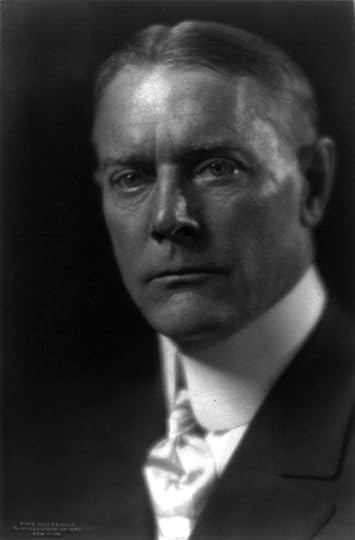
Albert Jeremiah Beveridge (October 6, 1862 – April 27, 1927) was an American historian and United States Senator from Indiana. He was an intellectual leader of the Progressive Era, and a biographer of justice John Marshall and President Abraham Lincoln.
Albert J. Beveridge was born on October 6, 1862 in Highland County, Ohio; his parents moved to Indiana soon after his birth. Both of his parents were of English descent. His childhood was one of hard work and labor. Securing an education with difficulty, he eventually became a law clerk in Indianapolis. He was admitted to the Indiana bar in 1887 and practiced law in Indianapolis.
Beveridge graduated from Indiana Asbury University (now DePauw University) in 1885, with a Ph.B. degree. He was a member of Delta Kappa Epsilon fraternity. He was known as a compelling orator, delivering speeches supporting territorial expansion by the U.S. and increasing the power of the federal government.
Beveridge entered politics in 1884 by speaking on behalf of Presidential candidate James G. Blaine and was prominent in later campaigns, particularly is that of 1896, when his speeches attracted general attention. In 1899, Beveridge was elected to the U.S. Senate as a Republican and served until 1911. He supported Theodore Roosevelt's progressive views and was the keynote speaker at the new Progressive Party convention which nominated Roosevelt for U.S. President in 1912.
Beveridge is known as one of the great American imperialists. He supported the annexation of the Philippines and along with Republican leader Henry Cabot Lodge he campaigned for the construction of a new navy. After Beveridge's re-election in 1905 to a second term, he became identified with the reform-minded faction of the GOP. He championed national child labor legislation, broke with President William Howard Taft over the Payne-Aldrich tariff, and sponsored the Federal Meat Inspection Act of 1906, adopted in the wake of the publication of Upton Sinclair's The Jungle.
He lost his senate seat to John Worth Kern when the Democrats took Indiana in the 1910 elections. In 1912, when former president Theodore Roosevelt left the Republican Party to found the short-lived Progressive Party, Beveridge left with him, and ran campaigns as that party's Indiana nominee in the 1912 race for governor and the 1914 race for senator, losing both. When the Progressive party disintegrated, he returned to the Republicans with his political future in tatters; he eventually ran one more unsuccessful race for Senate in the 1922 primary against Harry S. New, but would never again hold office.
In the twilight of his life, Beveridge came to repudiate some of the earlier expansion of governmental power that he had championed in his earlier career. In one notable address, delivered before the Sons of the Revolution's annual dinner in June 1923, Beveridge decried the growth of the regulatory state and the proliferation of regulatory bodies, bureaus and commissions. "America would be better off as a country and Americans happier and more prosperous as a people," he suggested, "if half of our Government boards, bureaus and commissions were abolished, hundreds of thousands of our Government officials, agents and employees were discharged and two-thirds of our Government regulations, restrictions and inhibitions were removed."
As his political career drew to a close, Beveridge dedicated his time to writing historical literature. He was a member and secretary of the American Historical Association (AHA). His 4-volume set The Life of John Marshall, published in 1916-1919 won Beveridge a Pulitzer Prize for Biography or Autobiography; it connected events in John Marshall's life with his later U.S. Supreme Court rulings.
Beveridge spent most of his final years after his 1922 defeat writing a 4-volume biography of Abraham Lincoln, which he only half-finished before his death, and which was posthumously published in 1928 as Abraham Lincoln, 1809-1858 (2 vols.), stripping away the myths to reveal a complex and imperfect politician. His accumulated materials for the continuance of the project were handed on to Carl Sandburg at his wife Catherine Eddy Beveridge's request. In 1939 the AHA established the Beveridge Award in his memory through a gift from Catherine Beveridge and donations from members.
There is a famous lost film of Leo Tolstoy made in 1901, a decade before he died. American travel lecturer Burton Holmes visited Yasnaya Polyana with Beveridge. As the three men conversed, Holmes filmed Tolstoy with his 60-mm movie camera. Afterwards, Beveridge's advisers succeeded in having the film destroyed, fearing that documentary evidence of a meeting with the radical Russian author might hurt his chances of running for the U.S. presidency.
(Source: Wikipedia)
More:
http://www.britannica.com/biography/A...
http://www.encyclopedia.com/topic/Alb...
https://www.mtholyoke.edu/acad/intrel...
http://legacy.fordham.edu/halsall/mod...
http://archive.vod.umd.edu/internat/B...
https://scholarworks.iu.edu/journals/...
https://en.wikisource.org/wiki/Albert...
http://china.usc.edu/us-senator-alber...
(no image)Albert J. Beveridge: American Nationalist by John Braeman (no photo)
(no image)Dictionary of Literary Biography: Twentieth-Century American Historians by Clyde Norman Wilson (no photo)
 by Edgar De Witt Jones (no photo)
by Edgar De Witt Jones (no photo) by Albert J. Beveridge (no photo)
by Albert J. Beveridge (no photo) by Albert J. Beveridge (no photo)
by Albert J. Beveridge (no photo) by Albert J. Beveridge (no photo)
by Albert J. Beveridge (no photo) by Albert Jeremiah Beveridge (no photo)
by Albert Jeremiah Beveridge (no photo) by Albert Jeremiah Beveridge (no photo)
by Albert Jeremiah Beveridge (no photo)
 Upton Sinclair
Upton Sinclair
Upton Beall Sinclair was a famous American writer and essayist whose book The Jungle, an exposé of Chicago's meatpacking industry, shocked the nation and led to the passage of the Pure Food and Drug Act in 1906.
Sinclair was born September 20, 1878, to a prominent but financially troubled family in Baltimore, Maryland. Sinclair's father was a liquor salesman who was also an alcoholic. His mother, a teetotaler, came from a wealthy background. In 1888, the Sinclair family moved to New York. Sinclair's father sold hats but spent his earnings on alcohol. Sinclair, who became a teetotaler like his mother, moved between two different financial worlds—the relative life of poverty with his father and mother and the affluence he experienced when visiting his mother's well-to-do parents. He later stated that experiencing the two extremes helped make him a socialist.
Sinclair began to write "dime novels" (books of pulp fiction that sold for 10 cents) when he was a teenager. At age 14, he attended New York City College, financing his education by writing for newspapers and magazines. In 1897, Sinclair enrolled at Columbia University. He continued to write prodigiously, a habit that became lifelong. By the time he died, Sinclair had published close to one hundred books.
In 1901, Sinclair released his first book, Springtime and Harvest, later republished as King Midas. Around the same time, he became involved in the socialist movement. He was an avid reader of socialist classics and Appeal to Reason, a socialist-populist journal. Socialists maintain that inequalities in the distribution of wealth are best solved by either direct state ownership of key industries or through regulation of private business. In 1905, Sinclair joined with authors Jack London and Florence Kelley and labor attorney clarence darrow to establish the Intercollegiate Socialist Society.
During this period Sinclair also became interested in the works of such investigative journalists as Lincoln Steffens and Ida Tarbell, who publicly exposed corruption in U.S. government and industry. This type of investigative reporting came to be known as "muckraking," thanks in part to Sinclair. In 1904, the editor of Appeal to Reason commissioned him to write a novel about the immigrants who worked in the meat packing industry. After seven weeks of research, Sinclair produced his sixth book, The Jungle, a novel about a young Lithuanian immigrant who finds work in the stockyards of Chicago. Sinclair's frank portrayal of the unsanitary and miserable working conditions of those who labored in the meat packing industry, was serialized in 1905 where it began to create a furor.
"I aimed at the public's heart, and by accident I hit it in the stomach."
—Upton Sinclair
Unable to find a publisher for his book, Sinclair, after six rejections, published the novel himself. He took out an ad in Appeal to Reason, and received 972 advance orders. When the publisher Doubleday heard the numbers, the company took on the book. The Jungle was published
in 1906 and immediately sold over 150,000 copies. Over the next few years the book was translated into 17 languages and became an international best-seller.
Horrified at the description of the filthy conditions in which the meat packers worked, and even more dismayed at the offal and other repellent ingredients that were part of the meats they were consuming, the American public demanded immediate and widespread reform. President Theodore Roosevelt met with Sinclair at the White House and launched an investigation into the practices of the meat packing industry. Although the beef industry and other producers of consumable products, including pharmaceutical companies, had vigorously fought federal regulation of their industries, Sinclair's revelations helped turn the tide.
Bowing to the swelling chorus of public indignation, Congress passed the pure food and drug act of 1906, which prohibited foreign and interstate commerce in adulterated or fraudulently labeled food and drugs. Under the new law, such products could be seized and destroyed and offenders faced fines and prison sentences. Congress also passed the Meat Inspection Act of 1906, which attempted to regulate the inspection of the slaughtering and processing of animals sold for human consumption.
Sinclair put his newfound wealth into a cooperative living experiment he established in Englewood, New Jersey. When a fire destroyed the commune in 1907, Sinclair was financially unable to rebuild it. He followed The Jungle with a number of other muckraking novels, including King Coal (1917), Oil! (1927), and Boston (1928). None, however, achieved the same popularity.
Sinclair eventually moved to California where he became actively involved in politics. He ran unsuccessfully for public office on the Socialist ticket and organized a socialist reform movement known as End Poverty in California (EPIC). In 1934, he ran for governor of California on the Democratic ticket, but was defeated by Republican incumbent Frank Merriam.
Sinclair returned to writing in the 1940s, producing his famous Lanny Budd series, which is composed of 11 novels that deal with American politics from about 1913 until 1953. The third book in the series, Dragon's Teeth (1942), recounts the rise of Nazism. It received the Pulitzer Prize for fiction in 1943, the only major literary award given to Sinclair.
In the 1950s, Sinclair moved to Arizona with his second wife, Mary Craig Kimbrough, for health reasons. When Craig died in 1961, the two had been married almost 50 years. Sinclair remarried at the age of 83. He spent his later years writing and occasionally lecturing. In 1962, he released his autobiography. In 1967, a year before his death, Sinclair was invited to the White House by President Lyndon Johnson to witness the signing of the Wholesome Meat Act of 1967, which expanded the earlier meat inspection act of 1906. In 1968, the socialist crusader, who proved that one man can bring about reform, died in his sleep on November 25, 1968, in Bound Brook, New Jersey.
(Source: Encyclopedia.com )
More:
https://en.wikipedia.org/wiki/Upton_S...
http://www.biography.com/people/upton...
http://www.nytimes.com/ref/timestopic...
http://www.online-literature.com/upto...
http://www.crf-usa.org/bill-of-rights...
http://spartacus-educational.com/Jupt...
https://en.wikipedia.org/wiki/Upton_S...
https://web.archive.org/web/201001062...
(no image)Upton Sinclair, American Rebel by Leon A Harris (no photo)
 by Anthony Arthur (no photo)
by Anthony Arthur (no photo) by Kevin Mattson (no photo)
by Kevin Mattson (no photo) by
by
 Harold Bloom
Harold Bloom by
by
 Upton Sinclair
Upton Sinclair by
by
 Upton Sinclair
Upton Sinclair by
by
 Upton Sinclair
Upton Sinclair by
by
 Lauren Coodley
Lauren Coodley by
by
 Greg Mitchell
Greg Mitchell
 David Graham Phillips
David Graham Phillips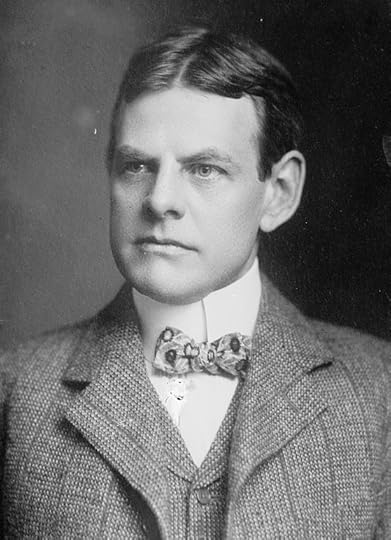
David Graham Phillips was born on Oct. 31, 1867, in Madison, Ind. During his happy and comfortable childhood he developed especially close ties to his older sister Carolyn. After high school Phillips entered Asbury (DePauw) University, where he roomed with the future U.S. senator Albert J. Beveridge, a man whom Phillips considered a symbol of the success that can come from hard work. When Beveridge graduated, Phillips went to Princeton, where he received a degree in 1887.
After college Phillips began working on the staff of the Cincinnati Times-Star. He wrote for a succession of newspapers, culminating his newspaper career as editorial writer for the New York World. His first novel, The Great God Success (1901), published under the pseudonym John Graham, won acclaim from popular critics and encouraged him to leave the World in 1902 to devote himself to "serious" writing. From then on he worked long hours on a regular daily schedule, writing 22 more novels, a play, and a series of essays.
Many of Phillips's novels employ journalistic techniques to examine the "hidden" story behind a dramatic situation, but this often results in pasteboard characterizations. He was interested in a variety of social problems. In The Second Generation (1907) he contrasts the evils of inherited wealth with the virtues of the working class. The Plum Tree (1905), Light Fingered Gentry (1907), and The Conflict (1911) consider the corruption of power and money that accompanied the rise of American democracy. He dealt with the social and economic situation of women in Old Wives for New (1908), The Hungry Heart (1909), The Price She Paid (1912), and his best-known novel, Susan Lenox (1917), the story of the rise to success of an illegitimate country girl turned prostitute.
Phillips's essays exposing corruption and greed in Congress, "The Treason of the Senate" (1906), appeared in Cosmopolitan and immediately brought reactions from men in power. His work was called sensational and distorted, and he acquired the title of muckraker. But he had little taste for bucking public opinion and so returned to fiction.
On Jan. 23, 1911, Phillips was shot by a mentally ill violinist who believed that Phillips's novel The Fashionable Adventures of Joshua Craig (1909) had libelously portrayed his family. Phillips died the next day. His sister Carolyn, with whom he had lived for years, prepared his last works for posthumous publication. (Source: Encyclopedia.com)
More:
https://en.wikipedia.org/wiki/David_G...
http://www.online-literature.com/davi...
http://spartacus-educational.com/USAp...
http://www.senate.gov/artandhistory/h...
https://hoffmanshistory.wikispaces.co...
http://www.roundaboutmadison.com/Insi...
http://www.infoplease.com/encyclopedi...
(no image)David Graham Phillips by Abe C. Ravitz(no photo)
(no image)Voice of the Democracy: A Critical Biography of David Graham Phillips: Journalist, Novelist, Progressive by Louis Filler (no photo)
(no image)Some American Story Tellers by Frederic Taber Cooper (no photo)
 by Anthony R. Fellow (no photo)
by Anthony R. Fellow (no photo) by
by
 David Graham Phillips
David Graham Phillips by
by
 David Graham Phillips
David Graham Phillips by
by
 David Graham Phillips
David Graham Phillips by
by
 David Graham Phillips
David Graham Phillips by
by
 David Graham Phillips
David Graham Phillips
 Interstate Commerce Commission - ICC
Interstate Commerce Commission - ICC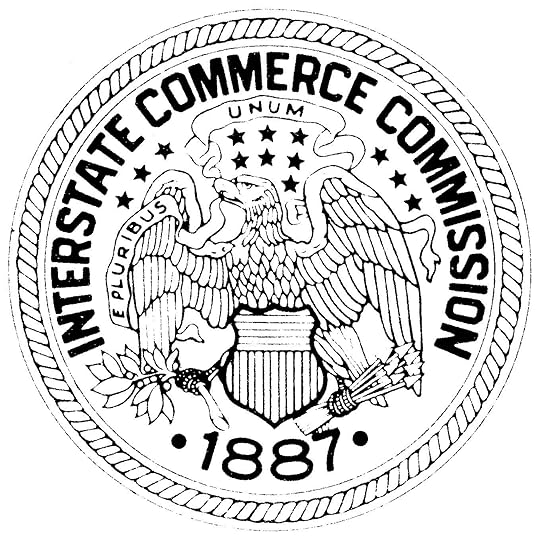
The Interstate Commerce Commission (ICC) was a regulatory agency in the United States created by the Interstate Commerce Act of 1887. The agency's original purpose was to regulate railroads (and later trucking) to ensure fair rates, to eliminate rate discrimination, and to regulate other aspects of common carriers, including interstate bus lines and telephone companies. Congress expanded ICC authority to regulate other modes of commerce beginning in 1906. The agency was abolished in 1995, and its remaining functions were transferred to the Surface Transportation Board.
The Commission's five members were appointed by the President with the consent of the United States Senate. This was the first independent agency (or so-called Fourth Branch).
Creation
The ICC was established by the Interstate Commerce Act of 1887, which was signed into law by President Grover Cleveland. The creation of the commission was the result of widespread and longstanding anti-railroad agitation. Western farmers, specifically those of the Grange Movement, were the dominant force behind the unrest, but Westerners generally — especially those in rural areas — believed that the railroads possessed economic power that they systematically abused. A central issue was rate discrimination between similarly situated customers and communities. Other potent issues included alleged attempts by railroads to obtain influence over city and state governments and the widespread practice of granting free transportation in the form of yearly passes to opinion leaders (elected officials, newspaper editors, ministers, and so on) so as to dampen any opposition to railroad practices.
Various sections of the Interstate Commerce Act banned "personal discrimination" and required shipping rates to be "just and reasonable."
Initial implementation and legal challenges
The Commission had a troubled start because the law that created it failed to give it adequate enforcement powers.
"The Commission is, or can be made, of great use to the railroads. It satisfies the popular clamor for a government supervision of the railroads, while at the same time that supervision is almost entirely nominal." - William H. H. Miller, US Attorney General, circa 1889.
Following passage of the 1887 act, the ICC proceeded to set maximum shipping rates for railroads. However, in the late 1890s several railroads challenged the agency's ratemaking authority in litigation, and the courts severely limited the ICC's powers.
Expansion of ICC authority
Congress expanded the commission's powers through subsequent legislation. The 1893 Railroad Safety Appliance Act gave the ICC jurisdiction over railroad safety, removing this authority from the states, and this was followed with amendments in 1903 and 1910. The Hepburn Act of 1906 authorized the ICC to set maximum railroad rates, and extended the agency's authority to cover bridges, terminals, ferries, sleeping cars, express companies and oil pipelines.
A long-standing controversy was how to interpret language in the Act that banned long haul-short haul fare discrimination. The Mann-Elkins Act of 1910 addressed this question by strengthening ICC authority over railroad rates, This amendment also expanded the ICC's jurisdiction to include regulation of telephone, telegraph and wireless companies.
The Valuation Act of 1913 required the ICC to organize a Bureau of Valuation that would assess the value of railroad property. This information would be used to set rates.
In 1934, Congress transferred the telecommunications authority to the new Federal Communications Commission.
In 1935, Congress passed the Motor Carrier Act, which extended ICC authority to regulate interstate bus lines and trucking as common carriers.
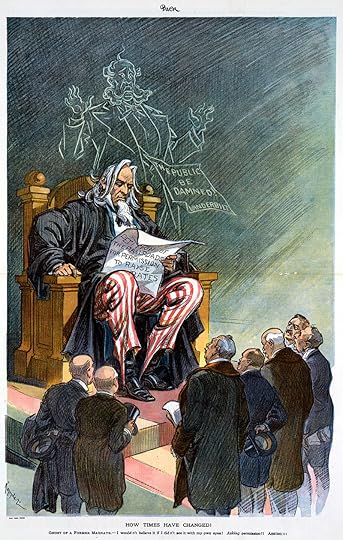
A 1914 cartoon shows railroad companies asking the ICC (depicted as Uncle Sam) for permission to raise rates, while the ghost of a horrified William Henry Vanderbilt looks on.
Ripley Plan to consolidate railroads into regional systems
The Transportation Act of 1920 directed the Interstate Commerce Commission to prepare and adopt a plan for the consolidation of the railway properties of the United States into a limited number of systems. Between 1920–3 William Z. Ripley, a professor of political economy at Harvard University, wrote up ICC's plan for the regional consolidation of the U.S. railways. His plan became known as the Ripley Plan. In 1929 the ICC published Ripley's Plan under the title Complete Plan of Consolidation. Numerous hearings were held by ICC regarding the plan under the topic "In the Matter of Consolidation of the Railways of the United States into a Limited Number of Systems". (Source: Wikipedia)
More:
https://www.federalregister.gov/agenc...
http://www.infoplease.com/encyclopedi...
http://www.britannica.com/topic/Inter...
http://www.encyclopedia.com/topic/Int...
http://www.referenceforbusiness.com/e...
(no image) The Work Of The Interstate Commerce Commission by Harry Turner Newcomb (no photo)
(no image) Interstates Commerce Commission by Statistics To The Commission (no photo)
(no image) Interstate Commerce Commission Report by Robert W Fyfe (no photo)
(no image) Interstate Commerce Commission Reports: Decisions of the Interstate Commerce Commission of the ... by United States Interstate Commerce Commission (no photo)
(no image) Before the Interstate commerce commission by
 U.S. Congress
U.S. Congress
 Federal Meat Inspection Act
Federal Meat Inspection Act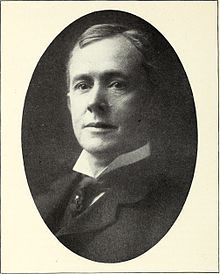
James Bronson Reynolds, 1907
The Federal Meat Inspection Act of 1906 (FMIA) is a United States Congress Act that works to prevent adulterated or misbranded meat and meat products from being sold as food and to ensure that meat and meat products are slaughtered and processed under sanitary conditions. These requirements also apply to imported meat products, which must be inspected under equivalent foreign standards. USDA inspection of poultry was added by the Poultry Products Inspection Act of 1957. The Food, Drug, and Cosmetic Act authorizes the Food and Drug Administration (FDA) to provide inspection services for all livestock and poultry species not listed in the FMIA or PPIA, including venison and buffalo. The Agricultural Marketing Act authorizes the USDA to offer voluntary, fee-for-service inspection services for these same species.
The original 1906 Act authorized the Secretary of Agriculture to inspect and condemn any meat product found unfit for human consumption. Unlike previous laws ordering meat inspections, which were enforced to assure European nations from banning pork trade, this law was strongly motivated to protect the American diet. All labels on any type of food had to be accurate (although not all ingredients were provided on the label). Even though all harmful food was banned, a few warnings were still provided on the container. The law was partly a response to the publication of Upton Sinclair's The Jungle, an exposé of the Chicago meat packing industry, as well as to other Progressive Era muckraking publications of the day. While Sinclair's dramatized account was intended to bring attention to the terrible working conditions in Chicago, the public was more horrified by the prospect of bad meat.
The book's assertions were confirmed in the Neill-Reynolds report, commissioned by President Theodore Roosevelt in 1906. Roosevelt was suspicious of Sinclair's socialist attitude and conclusions in The Jungle, so he sent labor commissioner Charles P. Neill and social worker James Bronson Reynolds, men whose honesty and reliability he trusted, to Chicago to make surprise visits to meat packing facilities.
Despite betrayal of the secret to the meat packers, who worked three shifts a day for three weeks to thwart the inspection, Neill and Reynolds were still revolted by the conditions at the factories and at the lack of concern by plant managers (though neither had much experience in the field). Following their report, Roosevelt became a supporter of regulation of the meat packing industry, and, on June 30, signed the Meat Inspection Act of 1906. (Source: Wikipedia)
Charles Patrick Neill

Charles Patrick Neill (1865–1942) was an American civil servant who raised in Austin, Texas after his family emigrated from Ireland in 1850. Neill graduated from Johns Hopkins University in 1897 with a doctorate in economics and politics. He was appointed the United States Commissioner of Labor in 1906 by President Theodore Roosevelt. As Commissioner of Labor he helped inspect the Meat Packing industries, and reported women and child labor injustices. He also mediated labor disputes between workers and employers in the coal, railroad, and steel corporations. (Source: Wikipedia)
More:
http://archives.chicagotribune.com/19...
http://digitalvaults.org/record/1487....
http://federal.laws.com/meat-inspecti...
http://www.bls.gov/bls/history/commis...
http://www.theodore-roosevelt.com/ima...
http://www.fsis.usda.gov/wps/wcm/conn...
http://millercenter.org/president/roo...
http://query.nytimes.com/gst/abstract...
http://news.hrvh.org/veridian/cgi-bin...
https://news.google.com/newspapers?ni...
 by U.S House Committee on Agriculture (no photo)
by U.S House Committee on Agriculture (no photo) by Gabriel Kolko (no photo)
by Gabriel Kolko (no photo) by Jim Powell (no photo)
by Jim Powell (no photo) by
by
 Upton Sinclair
Upton Sinclair by
by
 Theodore Roosevelt
Theodore Roosevelt
 American Federation of Labor
American Federation of Labor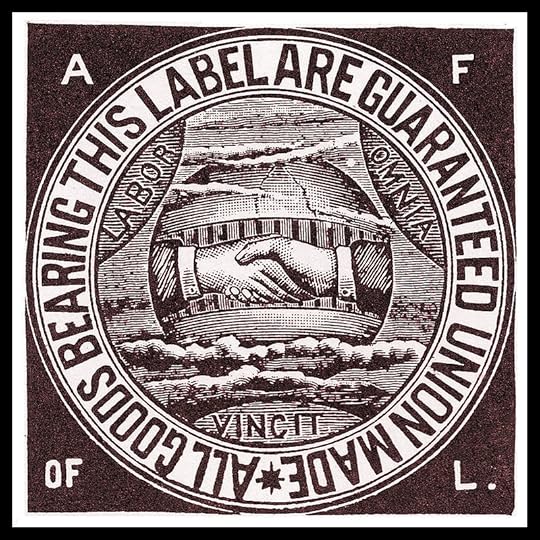
The American Federation of Labor (AFL) was a national federation of labor unions in the United States. It was founded in Columbus, Ohio, in May 1886 by an alliance of craft unions disaffected from the Knights of Labor, a national labor association. Samuel Gompers of the Cigar Makers' International Union was elected president of the Federation at its founding convention and was reelected every year except one until his death in 1924. The AFL was the largest union grouping in the United States for the first half of the 20th century, even after the creation of the Congress of Industrial Organizations (CIO) by unions that were expelled by the AFL in 1935 over its opposition to industrial unionism. While the Federation was founded and dominated by craft unions throughout the first fifty years of its existence, many of its craft union affiliates turned to organizing on an industrial union basis to meet the challenge from the CIO in the 1940s.
In 1955, the AFL merged with its longtime rival, the Congress of Industrial Organizations, to form the AFL-CIO, a federation which remains in place to this day. Together with the new union, the AFL has comprised the longest lasting and most influential labor federation in the United States.
(Source: Wikipedia)
More:
http://www.ushistory.org/us/37d.asp
http://lcweb2.loc.gov:8081/ammem/amrl...
http://www.ohiohistorycentral.org/w/A...
http://www.newworldencyclopedia.org/e...
http://www.digitalhistory.uh.edu/disp...
http://study.com/academy/lesson/the-a...
(no image)History of the Labor Movement in the United States: Vol. 2 by Philip S. Foner (no photo)
(no image)Seventy Years of Life and Labour: An Autobiography by Samuel Gompers (no photo)
(no image)Some Reasons for Chinese Exclusion; Meat vs. Rice, American Manhood Against Asiatic Coolieism. Which Shall Survive? by American Federation of Labor (no photo)
 by American Federation of Labor (no photo)
by American Federation of Labor (no photo) by Gwendolyn Mink (no photo)
by Gwendolyn Mink (no photo) by Robert Justin Goldstein (no photo)
by Robert Justin Goldstein (no photo) by Sidney Fine (no photo)
by Sidney Fine (no photo) by David Montgomery (no photo)
by David Montgomery (no photo) by Julie Greene (no photo)
by Julie Greene (no photo)
 Samuel Gompers
Samuel Gompers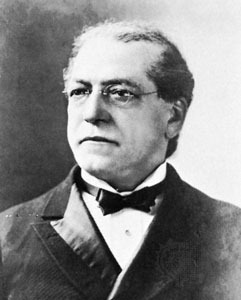
Samuel Gompers, (born January 27, 1850, London, England—died December 13, 1924, San Antonio, Texas, U.S.) American labour leader and first president of the American Federation of Labor (AFL).
Gompers emigrated in 1863 from England to New York City, where he took up his father’s trade of cigar making and in 1872 became a naturalized citizen. His careful leadership of labour interests earned Gompers a reputation for conservatism. In a period when the United States was bitterly hostile to labour organizations, he developed the principles of “voluntarism,” which called for unions to exert coercion by economic actions—that is, through strikes and boycotts. In 1886 Gompers fostered the separation of the cigar makers and other craft unions from the Knights of Labor to form the AFL, of which he was president from 1886 to 1924 (except for one year, 1895). He distrusted intellectual reformers, fearing their influence would divert labour’s efforts away from economic goals. To make unionism respectable as a bulwark against radicalism and irresponsible strikes, he encouraged binding written trade agreements and advocated the primacy of national organizations over both local unions and international affiliations.
Gompers kept the AFL politically neutral until pressed by employer tactics, including an open-shop drive, and by federal court injunctions that greatly weakened labour’s economic weapons, such as the strike, picket line, and boycott. The Democratic presidential platform of 1908 included an anti-injunction plank; hence, Gompers supported William Jennings Bryan’s unsuccessful presidential candidacy. Better political conditions for labour would follow: the victory of Woodrow Wilson in 1912 brought the creation of a U.S. cabinet post for labour (1913), followed by the Clayton Antitrust Act (1914) and passage of the Adamson Act (1916), which established the eight-hour workday for interstate railroad workers.
Gompers is noted for having shifted the primary goal of American unionism away from social issues and toward the “bread and butter” issues of wages, benefits, hours, and working conditions, all of which could be negotiated through collective bargaining. Gompers’s AFL became the model of unionism in the United States, achieving economic goals through national trade unions that organized a network of locals and supported them.
(Source: Encyclopedia Britannica)
More:
https://en.wikipedia.org/wiki/Samuel_...
http://www.aflcio.org/About/Our-Histo...
http://www.notablebiographies.com/Gi-...
http://www.u-s-history.com/pages/h174...
http://www.encyclopedia.com/topic/Sam...
http://www.manythings.org/voa/people/...
http://www.shmoop.com/history-labor-u...
http://www.digitalhistory.uh.edu/disp...
http://biography.yourdictionary.com/s...
(no image)Seventy Years of Life and Labour: An Autobiography by Samuel Gompers (no photo)
(no image)The Samuel Gompers Papers, Vol. 1: The Making of a Union Leader, 1850-86 by Samuel Gompers (no photo)
(no image)American Labor and the War by Samuel Gompers (no photo)
 by American Federation of Labor (no photo)
by American Federation of Labor (no photo) by Robert H. Babcock (no photo)
by Robert H. Babcock (no photo) by Samuel Gompers (no photo)
by Samuel Gompers (no photo) by Harold C. Livesay (no photo)
by Harold C. Livesay (no photo) by Bernard Mandel (no photo)
by Bernard Mandel (no photo) by Marc Karson (no photo)
by Marc Karson (no photo)
 Representative James Wolcott Wadsworth, Jr.
Representative James Wolcott Wadsworth, Jr.
WADSWORTH, James Wolcott, Jr., (son of James Wadsworth), a Senator and a Representative from New York; born in Geneseo, N.Y., August 12, 1877; received preparatory education at St. Mark's School, Southboro, Mass.; graduated from Yale University in 1898; during the Spanish-American War served as a private in the Puerto Rican campaign in 1898; engaged in livestock and agricultural pursuits near Geneseo, N.Y., and as manager of a ranch in Texas 1911-1915; member, New York State assembly 1905-1910, serving as speaker 1906-1910; elected as a Republican to the United States Senate in 1914; reelected in 1920 and served from March 4, 1915, to March 3, 1927; unsuccessful candidate for reelection in 1926; chairman, Committee on Military Affairs (Sixty-sixth through Sixty-ninth Congresses); Republican whip 1915; resumed agricultural pursuits; elected to the Seventy-third and to the eight succeeding Congresses (March 4, 1933-January 3, 1951); was not a candidate for renomination in 1950; appointed by President Harry Truman chairman of the National Security Training Commission in 1951 and served until his death in Washington, D.C., June 21, 1952; interment in Temple Hill Cemetery, Geneseo, N.Y. (Source: United States House of Representatives)
More:
https://en.wikipedia.org/wiki/James_W....
http://coat.ncf.ca/our_magazine/links...
http://www.nndb.com/people/910/000054...
http://lcweb2.loc.gov/service/mss/ead...
http://query.nytimes.com/gst/abstract...
http://query.nytimes.com/gst/abstract...
http://query.nytimes.com/gst/abstract...
http://query.nytimes.com/gst/abstract...
http://query.nytimes.com/gst/abstract...
http://query.nytimes.com/gst/abstract...
http://query.nytimes.com/gst/abstract...
http://query.nytimes.com/gst/abstract...
https://www.geni.com/people/James-Wol...
(no image)James W. Wadsworth, Jr.: The Gentleman from New York by Martin L. Fausold (no photo)
(no image)The Wadsworths of the Genesee by Alden R. Hatch (no photo)
 by Victor H. Krulak (no photo)
by Victor H. Krulak (no photo) by David E. Kaiser (no photo)
by David E. Kaiser (no photo) by
by
 James T. Patterson
James T. Patterson
 Albert Baird Cummins
Albert Baird Cummins
CUMMINS, Albert Baird, a Senator from Iowa; born near Carmichaels, Greene County, Pa., February 15, 1850; attended the public schools, and a preparatory academy; graduated Waynesburg (Pa.) College in 1869; moved to Iowa; briefly engaged as a carpenter; clerked in the office of the recorder of Clayton County; moved to Allen County, Indiana in 1871 where he became deputy county surveyor and engaged in railroad building; moved to Chicago to study law; admitted to the Illinois bar in 1875 and commenced practice in Chicago; returned to Des Moines, Iowa, in 1878, where he continued the practice of law; member, State house of representatives 1888-1890; unsuccessful candidate for election to the United States Senate in 1894 and 1900; member of the Republican National Committee 1896-1900; Governor of Iowa 1902-1908, when he resigned, having been elected Senator; elected as a Republican to the United States Senate in 1908 to fill the vacancy caused by the death of William B. Allison; reelected in 1909, 1914, and again in 1920, and served from November 24, 1908, until his death on July 30, 1926; unsuccessful candidate for renomination in 1926; served as President pro tempore of the Senate during the Sixty-sixth through the Sixty-ninth Congresses; chairman, Committee on Civil Service and Retrenchment (Sixty-first and Sixty-second Congresses), Committee on the Mississippi River and its Tributaries (Sixty-third through Sixty-fifth Congresses), Committee on Interstate Commerce (Sixty-sixth and Sixty-seventh Congresses), Committee on Judiciary (Sixty-eighth and Sixty-ninth Congresses); died in Des Moines, Iowa, July 30, 1926; interment in Woodland Cemetery.
(Source: Biographical Directory of the United States Congress)
More:
https://en.wikipedia.org/wiki/Albert_...
http://www.nga.org/cms/home/governors...
http://uipress.lib.uiowa.edu/bdi/Deta...
https://www.geni.com/people/Albert-B-...
http://www.jstor.org/stable/40168546?...
http://iowahistoryjournal.com/governo...
http://ir.uiowa.edu/cgi/viewcontent.c...
http://query.nytimes.com/mem/archive-...
http://query.nytimes.com/mem/archive-...
http://query.nytimes.com/mem/archive-...
http://query.nytimes.com/mem/archive-...
(no image)A History of the People of Iowa by Cyrenus Cole (no photo)
(no image)Insurgency; Personalities and Politics of the Taft Era by Kenneth William Hechler (no photo)
 by Michael Kramme (no photo)
by Michael Kramme (no photo) by Benjamin F. Gue (no photo)
by Benjamin F. Gue (no photo) by James Holt (no photo)
by James Holt (no photo) by Robert Sobel (no photo) and John Raimo (no photo)
by Robert Sobel (no photo) and John Raimo (no photo) by Iowa Secretary of State (no photo)
by Iowa Secretary of State (no photo) by Deemer Lee (no photo)
by Deemer Lee (no photo)
 Charles Sanger Mellon
Charles Sanger Mellon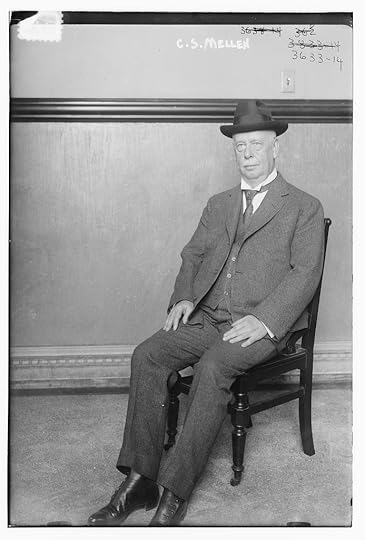
Charles Sanger Mellen (August 16, 1852 – November 17, 1927) was an American railroad man whose career culminated in the presidencies of the Northern Pacific Railway (1897-1903) and the New York, New Haven and Hartford Railroad (1903-1913). His goal, along with the New Haven's financier J. P. Morgan, was to consolidate, electrify and modernize all the main railroads of New England, so as to lower competition and produce higher profits. The result of his abrasive tactics alienated public opinion, led to high prices for acquisitions and costly construction; the accident rate soared when efforts were made to save on maintenance costs. Debt soared from $14 million in 1903 to $242 million in 1913, when it was hit by an anti-trust lawsuit by the federal government on the charge of monopolizing New England's rail traffic. He was called, "The last of the railway czars."
Mellen was born in Lowell, Massachusetts, United States, on August 16, 1852. His family soon moved to Concord, New Hampshire where he attended high school, graduating in 1867. Rather than attending college, he began his railroad career as a clerk at the Northern New Hampshire Railroad in Concord in 1870. After a short time at the Central Vermont Railroad and back to the Northern New Hampshire Railroad, he moved to the Boston and Lowell Railroad (B&L) where he was promoted to Superintendent. The Boston and Lowell enjoyed revenues from leasing use of its lines into Boston to the Boston and Maine Railroad. Its policies led the B&M to build its own line into Boston and to fight with the B&L to the New Hampshire courts. Mellen was the President of the B&L when it lost its court case, and ceased independent operations in 1887 when it was leased to the Boston and Maine Railroad. From 1888 to 1892 he was purchasing agent, then General Traffic Manager of the Union Pacific Railroad, where he formed a friendship with Diamond Jim Brady. In 1892, he became general manager of the New York and New England Railroad, during a time when it was engaged in a bitter war with the New Haven. Charles P. Clark, the New Haven's president, hired him away from his competitor in November 1892. Mellen later testified that "[Clark] said I was too much of a nuisance on the New England." Mellen came to the attention of J. P. Morgan when he drove such a hard bargain with the New York Central that Chauncey Depew complained to Morgan, a director of both the New Haven and the New York Central. Morgan's grandfather was an original investor in the Hartford and New Haven Railroad, one of the two principal predecessors of the New Haven. His interests had led him to become a director of the New Haven in 1891.
Morgan's bank had become receiver of the Northern Pacific in August 1893. Mellen had an active role in the reorganization and became president of the NP when it emerged from receivership in 1896. During his tenure there, NP's gross revenue increased by 156%, some of the increase at the expense of the Great Northern Railway (GN), part of the same supposedly anti-competitive Northern Securities Company as the NP. Furthermore, Mellen made acquisitions that enabled the NP to reach the Pacific and thereby compete with the GN over its entire route. James J. Hill, founder of the GN and part of the Trust, called Mellen and his Morgan-appointed predecessor there "overrated underachievers". But by this time Mellen had become a staunch Morgan man. He told reporters, "I wear the Morgan collar, but I am proud of it." But yet he was not fully informed about the machinations of Morgan, Hill, and Harriman concerning stock in his company. On Monday, May 6, 1901 the Morgan interests were buying up NP stock. On Tuesday Mellen wired an NP vice president in New York "Cannot you give me some idea what is transpiring, to explain tremendous movement our stock?".
When Charles P. Clark resigned as the New Haven's president in 1900, Mellen made inquiries for the job, but Morgan needed him at the NP. By 1903 Morgan's priorities had changed. Upon assuming the New Haven presidency Mellen undertook a program of "Morganization" of transportation in New England that extended from railroads to steamship lines and street railways. The New Haven even bought control of the chronically unprofitable New York, Ontario and Western Railway. His efforts, in particular the attempted takeover of the Boston and Maine Railroad, brought him into public contention with anti-trust lawyer Louis Brandeis in Massachusetts. In May 1908 Morgan's partner George Walbridge Perkins wrote to Morgan: "I still feel, as I have for couple of years, that Mr. Mellen is getting the New Haven into considerable of a muddle by his financial methods and this, I think, is becoming more or less the general opinion." The failed Morganization of the New Haven was among the great embarrassments to the Morgan interests. The Mellen-Morgan policies led to the New Haven's future financial troubles, culminating in bankruptcy in 1935. Mellen's Morganization efforts in New England also put him in executive positions at the Maine Central Railroad, the New York, Ontario and Western Railway, and the Boston and Maine Railroad.
His goal, along with the New Haven's financier J. P. Morgan, was to consolidate, electrify and modernize all the main railroads of New England, so as to lower competition and produce higher profits. The result of his abrasive tactics alienated public opinion, led to high prices for acquisitions and costly construction; the accident rate soared when efforts were made to save on maintenance costs. Debt soared from $14 million in 1903 to $242 million in 1913, when it was hit by an anti-trust lawsuit by the federal government on the charge of monopolizing New England's rail traffic. He was called, "The last of the railway czars."
J. P. Morgan was aged and ill when the difficulties of the New Haven and other efforts led him to be summoned to give testimony before the Pujo Committee. Morgan died on March 31, 1913. Mellen shouldered the burden of testifying and faced indictments. He provided testimony concerning nearly $10,000,000 disbursed in connection with acquiring the franchise for the New York, Westchester and Boston Railway and resolving a franchise dispute with the New York and Port Chester Railroad. (Source: Wikipedia)
More:
http://www.glabarre.com/item/Charles_...
http://www.glabarre.com/item/Charles_...
http://labarregalleries.blogspot.hr/2...
http://trove.nla.gov.au/newspaper/art...
https://en.wikipedia.org/wiki/Norther...
https://en.wikipedia.org/wiki/New_Yor...
(no image)Collectible Stocks and Bonds from North American Railroads Guide with prices, second edition by Terry Cox (no photo)
(no image) The New Haven Railroad: Its Rise And Fall by John L Weller (no photo)
 by John N. Ingham (no photo)
by John N. Ingham (no photo) by Mehmet A Odekon (no photo)
by Mehmet A Odekon (no photo) by Vincent Carosso (no photo)
by Vincent Carosso (no photo) by
by
 Ron Chernow
Ron Chernow
 John Sharp Williams
John Sharp Williams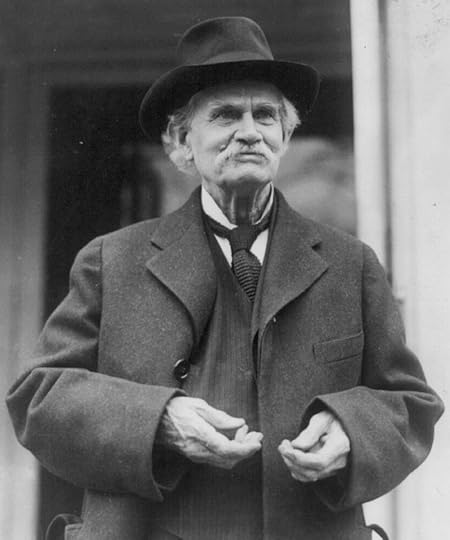
WILLIAMS, John Sharp, (grandson of Christopher Harris Williams), a Representative and a Senator from Mississippi; born in Memphis, Tenn., July 30, 1854; after the death of his parents moved to Yazoo County, Miss.; attended private schools, the Kentucky Military Institute near Frankfort, the University of the South, Sewanee, Tenn., the University of Virginia at Charlottesville, and the University of Heidelberg, at Baden, Germany; subsequently studied law at the University of Virginia and in Memphis, Tenn.; admitted to the bar in 1877; moved to Yazoo City, Miss., in 1878; engaged in the practice of law and also interested in cotton planting; elected as a Democrat to the Fifty-third and to the seven succeeding Congresses (March 4, 1893-March 3, 1909); was not a candidate for renomination in 1908; minority leader in the Fifty-eighth, Fifty-ninth, and Sixtieth Congresses; chairman, Committee on Party Leaders (Fifty-eighth through Sixtieth Congresses); elected as a Democrat to the United States Senate in 1910; reelected in 1916 and served from March 4, 1911, to March 3, 1923; declined to be a candidate for renomination in 1922; chairman, Committee to Audit and Control the Contingent Expenses (Sixty-third Congress), Committee on the Library (Sixty-fourth and Sixty-fifth Congresses), Committee on the University of the United States (Sixty-sixth Congress); retired from public life and lived on his plantation, ’Cedar Grove,’ near Yazoo City, Miss., until his death there September 27, 1932; interment in the family cemetery on his plantation. (Source: Biographical directory of the United States Congress)
More:
https://en.wikipedia.org/wiki/John_Sh...
http://www.bartleby.com/73/295.html
http://kitwilliams.com/family_bible/i...
https://en.wikisource.org/wiki/Author...
http://mshistorynow.mdah.state.ms.us/...
http://www.jstor.org/stable/3739648?s...
http://www.nndb.com/people/063/000206...
http://www.olemiss.edu/depts/general_...
http://history.house.gov/People/Detai...
(no image)Party Leaders In The House Of Representatives by Randall B. Ripley (no photo)
(no image)Thomas Jefferson, His Permanent Influence on American Institutions by John Sharp Williams (no photo)
 by James B. Lloyd (no photo)
by James B. Lloyd (no photo) by Sandra Wilkins (no photo)
by Sandra Wilkins (no photo) by Robert Allen Rutland (no photo)
by Robert Allen Rutland (no photo) by Galbraith Schlisinger (no photo)
by Galbraith Schlisinger (no photo)
 Elkins AntiRebate Act of 1903
Elkins AntiRebate Act of 1903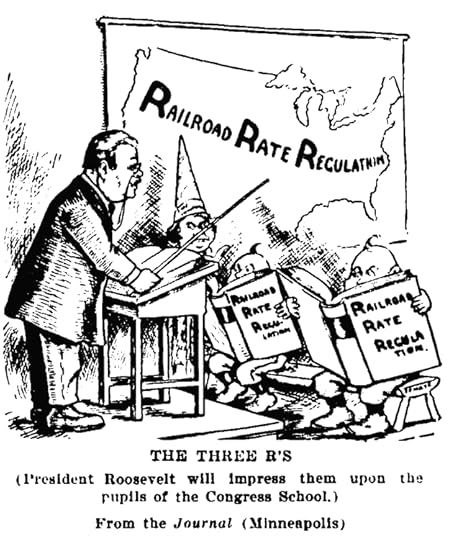
The Elkins Act is a 1903 United States federal law that amended the Interstate Commerce Act of 1887. The Act authorized the Interstate Commerce Commission (ICC) to impose heavy fines on railroads that offered rebates, and upon the shippers that accepted these rebates. The railroad companies were not permitted to offer rebates. Railroad corporations, their officers, and their employees, were all made liable for discriminatory practices.
Prior to the Elkins Act, the livestock and petroleum industries paid standard rail shipping rates, but then would demand that the railroad company give them rebates. The railroad companies resented being extorted by the railroad trusts and therefore welcomed passage of the Elkins Act. The law was sponsored by President Theodore Roosevelt as a part of his "Square Deal" domestic program, and greatly boosted his popularity.
Background
Congress passed the Elkins Act as an amendment to the Interstate Commerce Act. Without restrictive legislation, large firms could demand rebates or prices below the collusive price from railroad companies as condition for their business. As a result, it was common practice for railroads to offer competitive lower rates for transport between the large cities with high density of firms than the monopolistic rates between less industrial cities, irrespective of length of travel. Trusts constituted such a substantial portion of a carrier's revenue that the trusts could demand rebates as a condition for business, and the carrier would be forced to cooperate.
Purpose
The ICC had been unable to protect competition and fair pricing. Section 2 of the Interstate Commerce Act prohibits a carrier from offering preferential prices or rebates; however, enforcement of this section was ineffective. Powerful trusts would pay the standard shipping price, but demand a rebate from the carrier. Court cases brought before the commission generally did not result in punitive action, as the ICC was composed primarily of railroad interests. Carriers found guilty of price discrimination, moreover, could appeal the ICC decision to federal courts, delaying punishment for years.
The Elkins Act was named for its sponsor, Senator Stephen B. Elkins of West Virginia, who introduced a bill in 1902 at the behest of the Pennsylvania Railroad. The law was passed by the 57th Congress and signed by President Roosevelt on February 19, 1903. The Act made it a misdemeanor for a carrier to impose preferential rebates, and implicated both the carrier and the recipient of the low price. The Act also abolished imprisonment as a punishment for breaching the law, so a violator could only be fined. By reducing the severity of punishment, legislators hoped to encourage firms to testify against each other, and promote stricter enforcement of the law.
Impact
Following the passage of the Elkins Act, real freight rates decreased only slightly. In 1905, leaders in the regulation movement testified before Congress to identify the reduction in prices that resulted from the Act. Yet, in the first months following the passage of the law, the most pronounced change in railroad pricing was the elimination of rebates. However, later analysis has found that decreases in carrier prices are better attributable to decreases in the costs of operation due to technology advances. The elimination of rebates led the railroads to seek other methods to compete for business, leading >b>Governor Albert B. Cummins of Iowa to declare, in 1905, that the elimination of rebates simply forces railroads to seek alternative noncompetitive means to secure business. The Elkins Act, thus, was more effective in stabilizing prices and entrenching price collusion than demonstrably lowering prices.
A diverse group of stakeholders publicly supported the Elkins Act. Citizens who supported the law hoped that reducing price discrimination would lower freight prices uniformly, and railroad interests lobbied for the passage of the Act as a means of enforcing collusive pricing. While the Act restricted preferential pricing, it did not specify what constituted a "reasonable" shipping rate; thus, railroads could use the law to entrench a system of collusive prices. Collusion is unsustainable in a market where it is easy to undercut competitors. However, in industries that only have a small number of competitors (e.g. railroads, airlines, or transportation companies operating between two given cities), collusion is far more likely. The result of the Elkins Act was that Railroads had a stronger mechanism to protect their collusive prices and corporate trusts were weakened in their ability to gain shipping discounts. Farmers and other railroad users, instead of benefiting from greater competition, were unaffected by the Act.
While farmers may have benefited from the establishment of a price ceiling on freight rates, the nature of the railroad industry may have not have permitted perfect competition. Economist Robert Harbeson argues that the price wars prior to the Elkins Act suggest that the railroad industry was more oligopolistic. In an industry with decreasing marginal costs and high fixed costs, it would be futile to enforce a price cap. Moreover, he argues, stronger regulation would have prevented carriers from reaching economies of scale.
Contemporary criticism
In reaction to the Elkins Act, it was argued that the law was drafted by Congress on behalf of the railroads, and that while some railroads curtailed rebates for some customers, for others the practice continued unabated. Congress was criticized for enacting only monetary fines for violations of the law and avoiding imposition of criminal penalties.
Subsequent legislation
Citing the shortcomings of the Elkins Act, Progressives began to call for greater regulation of railroad interests, and, in 1906, President Roosevelt signed the Hepburn Act to replace the Elkins Act. The Hepburn Act set maximum freight rates for railroads, representing the greater interests of Americans. The regulations of the Hepburn Act strained railroads, which saw new competition from the rise of trucks and automobiles. The Panic of 1907 was, in part, a result of the turmoil of the railroad industry that resulted from the Hepburn Act. (Source: Wikipedia)
More:
http://query.nytimes.com/gst/abstract...
http://www.theodorerooseveltcenter.or...
http://study.com/academy/lesson/the-e...
http://sk.sagepub.com/reference/socia...
http://chroniclingamerica.loc.gov/lcc...
http://definitions.uslegal.com/e/elki...
http://kevinsapushguide.weebly.com/te...
 by Robert F. Bruner (no photo)
by Robert F. Bruner (no photo) by
by
 Doris Kearns Goodwin
Doris Kearns Goodwin by
by
 Douglas G. Brinkley
Douglas G. Brinkley by
by
 Francis Fukuyama
Francis Fukuyama by
by
 Michael Dahlen
Michael Dahlen
 Bourbon Democrats
Bourbon Democrats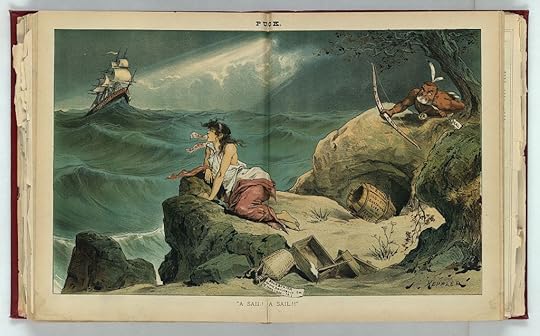
A 1884 J. Keppler's cartoon illustrating the decline of the "Democrat Bourbonism" (represented as a broken cask).
Bourbon Democrat was a term used in the United States from 1876 to 1904 to refer to a conservative or classical liberal member of the Democratic Party, especially one who supported Charles O'Conor in 1872, Samuel J. Tilden in 1876, President Grover Cleveland in 1884–1888/1892–1896 and Alton B. Parker in 1904. After 1904, the Bourbons faded away. Woodrow Wilson, who had been a Bourbon, made a deal in 1912 with the leading opponent of the Bourbons, William Jennings Bryan; Bryan endorsed Wilson for the Democratic nomination, and Wilson named Bryan Secretary of State. The term "Bourbon" was mostly used disparagingly, by critics complaining of old-fashioned viewpoints.
Bourbon Democrats were promoters of a form of laissez-faire capitalism which included opposition to the protectionism that the Republicans were then advocating as well as fiscal discipline. They represented business interests, generally supporting the goals of banking and railroads but opposed to subsidies for them and were unwilling to protect them from competition. They opposed imperialism and U.S. overseas expansion, fought for the gold standard, and opposed bimetallism and promoted hard and sound money. Strong supporters of reform movements such as the Civil Service Reform and opponents of the corrupt city bosses, Bourbons led the fight against the Tweed Ring. The anti-corruption theme earned the votes of many Republican Mugwumps in 1884.
Factional history
The nickname Bourbon Democrat was first used as a pun, referring to bourbon whiskey from Kentucky and even more to the Bourbon Dynasty of France, which was overthrown in the French Revolution but returned to power in 1815 to rule in a reactionary fashion until its final overthrow in the July Revolution of 1830.
The term was occasionally used in the 1860s and 1870s to refer to conservative Democrats (both North and South) who still held the ideas of Jefferson and Jackson, and in the 1870s to refer to the regimes set up in the South by Redeemers as a conservative reaction against Reconstruction.
Gold Democrats and Bryan
The electoral system elevated Bourbon Democrat leader Grover Cleveland to the office of President both in 1884 and in 1892, but the support for the movement declined considerably in the wake of the Panic of 1893. President Cleveland, a staunch believer in the gold standard, refused to inflate the money supply with silver, thus alienating the agrarian populist wing of the Democratic Party.
The delegates at the 1896 Democratic National Convention quickly turned against the policies of Grover Cleveland and those advocated by the Bourbon Democrats, favoring bimetallism as a way out of the depression. Nebraska congressman William Jennings Bryan now took the stage as the great opponent of the Bourbon Democrats. Harnessing the energy of an agrarian insurgency with his famous Cross of Gold speech, Congressman Bryan soon became the Democratic nominee for President in the 1896 election.
Some of the Bourbons sat out the 1896 election or tacitly supported McKinley, the Republican nominee; others set up the third-party ticket of the National Democratic Party led by John M. Palmer, a former governor of Illinois. These bolters, called "gold Democrats", mostly returned to the Democratic party by 1900 or by 1904 at the latest. Bryan demonstrated his hold on the party by winning the 1900 and 1908 Democratic nominations as well; in 1904, a Bourbon, Alton B. Parker, won the nomination. He lost in the presidential race, as did Bryan every time.
William L. Wilson, President Cleveland's Postmaster General, confided in his diary that he opposed Bryan on moral and ideological as well as party grounds. Wilson had begun his public service convinced that special interests had too much control over Congress, and his unsuccessful tariff fight had burned this conviction deeper. He feared the triumph of free silver would bring class legislation, paternalism, and selfishness feeding upon national bounty as surely as did protection. Moreover, he saw the proposed unlimited coinage of silver at a ratio of 16 to 1 to gold as morally wrong, "involving as it does the attempt to call 50 cents a dollar and make it legal tender for dollar debts". Wilson regarded populism as "the product of protection founded on the idea that Government can and therefore Government ought to make people prosperous."
Decline
The nomination of Alton Parker in 1904 gave a victory of sorts to pro-gold Democrats, but it was a fleeting one. The old classical liberal ideals had lost their distinctiveness and appeal. By World War I, the key elder statesman in the movement, John M. Palmer, as well as Simon Bolivar Buckner, William F. Vilas, and Edward Atkinson, had died. During the 20th century, classical liberal ideas never influenced a major political party as much as they influenced the Democrats in the early 1890s. (Source: Wikipedia)
More:
http://www.conservapedia.com/Bourbon_...
https://www.washingtonpost.com/opinio...
https://www.americanhistoryusa.com/to...
http://ashbrook.org/publications/oped...
http://liberapedia.wikia.com/wiki/Bou...
 by John M. Pafford (no photo)
by John M. Pafford (no photo) by
by
 Paul Krugman
Paul Krugman by
by
 Brion T. McClanahan
Brion T. McClanahan by
by
 Eric Foner
Eric Foner by
by
 George Packer
George Packer
 Nelson Aldrich
Nelson Aldrich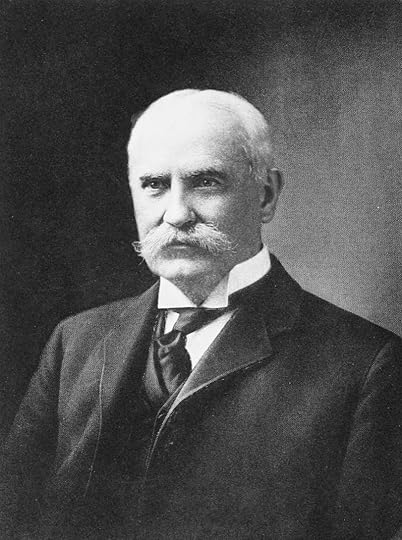
Nelson Wilmarth Aldrich (November 6, 1841 – April 16, 1915) was a prominent American politician and a leader of the Republican Party in the Senate, where he served from 1881 to 1911. By the 1890s he was one of the "Big Four" key Republicans who largely controlled the major decisions of the Senate.
Because of his impact on national politics and central position on the pivotal Senate Finance Committee, he was referred to by the press and public alike as the "General Manager of the Nation", dominating all tariff and monetary policies in the first decade of the 20th century. In a career that spanned three decades, Aldrich helped to create an extensive system of tariffs that protected American factories and farms from foreign competition. He was a party to the re-structuring of the American financial system through the institution of the federal income tax amendment, which he originally opposed. His most important contribution was the design of the modern Federal Reserve System. Deeply committed to the efficiency model of the Progressive Era, he believed these reforms would lead to greater efficiency. Reformers, however, denounced him as representative of the evils of Big business. Aldrich became wealthy with investments in street railroads, sugar, rubber and banking. He married into the Rockefeller family, and his descendents became powerful figures in American politics and banking.
Family background
Aldrich was born in Foster, Rhode Island, into a middle-class family descended from noted English immigrants John Winthrop, William Wickenden, and Roger Williams. His branch passed through generations of declining circumstances. His father was Anan E. Aldrich, a mill hand, and mother Abby Burgess. He attended public schools in East Killingly, Conn. and the East Greenwich Academy a boarding school in Rhode Island.
Early career
Aldrich's home in Providence, a National Historic Landmark
Aldrich's first job was clerking for the largest wholesale grocer in the state, where he worked his way up to become a partner in the firm.
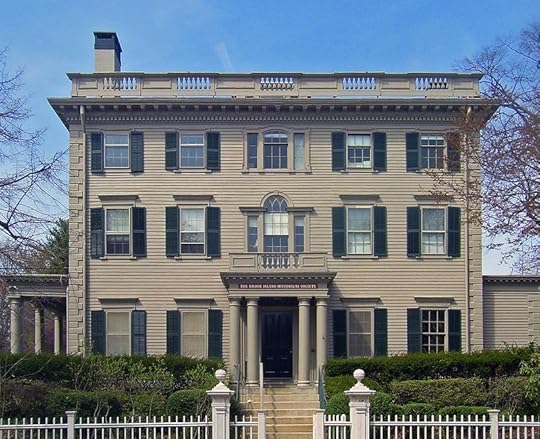
Aldrich's home in Providence, a National Historic Landmark
He served briefly in the Union Army during the American Civil War when he enlisted as a private in Company D of the 10th Rhode Island Infantry on May 26, 1862. Aldrich's company served for three months at Fort DeRussy, which was part of the defenses of Washington, D.C.. Aldrich was mustered out of service with the regiment on September 1, 1862.
On October 9, 1866, he married Abigail Pearce Truman "Abby" Chapman, a wealthy woman with impressive antecedents. They had a total of eleven children.
Political career
By 1877, Nelson had a major effect on state politics, even before his election to the United States Congress. He served as a member of the Providence City Council from 1869 to 1874 and as its president in 1872 and 1873. He served in the Rhode Island House of Representatives in 1875 and 1876 and served as Speaker of the House in 1876.
U.S. Senate
In 1878 the Republican bosses of Rhode Island endorsed him for the US House of Representatives; he won and served one term, 1879 to 1881. In 1881 he was elected to the U.S. Senate by the Rhode Island legislature. He served in the Senate for 30 years from 1881 to 1911. He was the longest serving United States Senator from Rhode Island before the 36-year tenure of Claiborne Pell in the late 20th Century.
By the 1890s he was one of the "Big Four" key Republicans who largely controlled the major decisions of the Senate, along with William B. Allison of Iowa, John Coit Spooner of Wisconsin. and Thomas C. Platt of New York. Aldrich's main power base was his chairmanship of the Senate Finance Committee which oversaw bank regulation and monetary policy.
In 1906 Aldrich sold his interest in the Rhode Island street railway system to the New York, New Haven and Hartford Railroad, whose president, Charles Sanger Mellen, was Wall Street banker J. P. Morgan's loyal ally.
National finance
The panic of 1907 led to the passage of the Aldrich–Vreeland Act in 1908, which established the National Monetary Commission, sponsored and headed by Aldrich. After issuing a series of 30 reports, this commission drew up the Aldrich Plan, forming the basis for the Federal Reserve system.
As co-author of the Payne-Aldrich Tariff Act of 1909, Aldrich removed restrictive import duties on fine art, which enabled Americans to bring in very expensive European artworks that became the foundation of many leading museums.
In 1909, Aldrich introduced a constitutional amendment to establish an income tax, although he had declared a similar measure "communistic" a decade earlier. Aldrich was quite candid about his scheme to block the House bill that had been passed, declaring to the Senate: "I shall vote for the corporation tax as a means to defeat the income tax."
The compromise passed unanimously in the Senate and by a vote of 318 to 14 in the House. The corporate excise tax would be levied, and the income-tax constitutional amendment would be sent out to the states for ratification—which Taft and Aldrich thought was impossible.
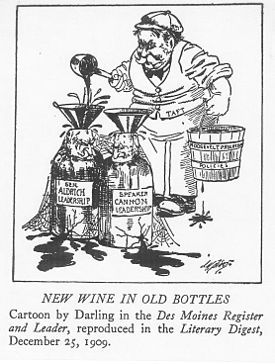
Taft tries to get progressive ideas into Aldrich
Aldrich also served as chairman of the Senate Republican Conference. During his Senate tenure he chaired the committees on Finance, Transportation Routes to the Seaboard, Rules, and the Select Committee on Corporations Organized in the District of Columbia.
Federal Reserve Act
Following the Panic of 1907, Aldrich took control as chairman of the Congressionally established National Monetary Commission. A proponent of Progressive Era themes of Efficiency and scientific expertise, he led a team of experts to study the European national banks. After his trip, he came to believe that Britain, Germany and France had much superior central banking systems. He worked with several key bankers and economists, including Paul Warburg, Abram Andrew and Henry Davison, to design a plan for an American central bank in 1911. In 1913 Woodrow Wilson signed the Federal Reserve Act patterned after Aldrich's vision into law, creating the modern Federal Reserve System.
Foreign affairs
Aldrich opposed entry into the Spanish–American War, but supported McKinley when it began. He played a central role in winning two-thirds Senate approval of the Treaty of Paris that ended the war, and included annexation of the Philippines. He helped frame the Platt Amendment of 1901, which limited the American role in Cuba. He supported the Panama Canal, but was critical of Roosevelt's general Caribbean policy. In 1906 Aldrich and other American financiers invested heavily in mines and rubber in the Belgian Congo. They supported Belgium's King Leopold II, who had imposed very harsh labor conditions in the colony.
Family Prominence
His daughter Abigail Greene "Abby" Aldrich was a philanthropist who married philanthropist John Davison Rockefeller, Jr., and their second son Nelson Aldrich Rockefeller was a four-term Governor of New York who campaigned for the Republican presidential nomination in 1960, 1964, and 1968, and was named Vice President of the United States under President Gerald Ford by the Congress in 1974. Aldrich's son Richard S. Aldrich served in Congress from 1923 to 1933, and his son Winthrop Williams Aldrich served as chairman of the Chase National Bank.
Interests
Aldrich was very active in the Freemasons and was Treasurer of the Grand Lodge of Rhode Island.
Aldrich developed an elaborate country estate in the Warwick Neck section of Warwick, Rhode Island. The estate is now owned by the Roman Catholic Diocese of Rhode Island.
Death and burial
He died on April 16, 1915, in New York City, and was buried in Swan Point Cemetery in Providence, Rhode Island.
Legacy
The Nelson W. Aldrich House on 110 Benevolent Street in Providence serves as the headquarters for the Rhode Island Historical Society.
The Aldrich Middle School in Warwick, Rhode Island is named in his honor. (Source: Wikipedia)
More:
http://bioguide.congress.gov/scripts/...
http://www.starkman.com/hippo/history...
http://www.britannica.com/biography/N...
http://www.senate.gov/artandhistory/a...
http://spartacus-educational.com/USAa...
(no image) Nelson W. Aldrich, A Leader In American Politics by Nathaniel W. Stephenson (no photo)
(no image) Nelson W. Aldrich: A Register and Index of His Papers in the Library of Congress by
 Library of Congress
Library of Congress by Jeffrey E. Cohen (no photo)
by Jeffrey E. Cohen (no photo) by David F. Trask (no photo)
by David F. Trask (no photo) by Nelson W. Aldrich (no photo)
by Nelson W. Aldrich (no photo)
 Standpatters
StandpattersStandpatters, in U.S. history, term used early in the 20th cent. to designate conservatives in the Republican party as against the Insurgents or progressive Republicans. The term is said to have originated in Mark Hanna's remark concerning an election—all that was necessary for Republican success was, in poker parlance, to "stand pat." (Source: Columbia Encyclopedia Free Dictionary)
More:
https://en.wikipedia.org/wiki/Cyrenus...
http://isites.harvard.edu/fs/docs/icb...
http://rboyd.web.wesleyan.edu/profile...
http://wikisum.com/w/Key:_The_respons...
http://www.heritage.org/initiatives/f...
(no image) The Standpatter: A Chronicle of Democracy by Ella Hamilton Durley (no photo)
 by Robert Marion La Follette (no photo)
by Robert Marion La Follette (no photo) by L. White Busbey (no photo)
by L. White Busbey (no photo) by
by
 Samuel P. Huntington
Samuel P. Huntington by
by
 Edmund Morris
Edmund Morris
 Orville Platt
Orville Platt
Orville Hitchcock Platt (July 19, 1827 – April 21, 1905) was a United States Senator from Connecticut.
Life and career
Born in Washington, Connecticut, he attended the common schools and graduated from The Gunnery in Washington. He studied law in Litchfield, and was admitted to the bar in 1850, commencing practice in Towanda, Pennsylvania. He moved to Meriden, Connecticut in 1850 and continued to practice law. He was clerk of the Connecticut Senate in 1855 and 1856, Secretary of the State of Connecticut in 1857, and a member of the State senate in 1861 and 1862. He was a member of the Connecticut House of Representatives in 1864 and 1869, and served as speaker in the latter year. The former Platt National Park in Oklahoma (since 1976 part of the Chickasaw National Recreational Area) was named for him.
Platt was state's attorney for New Haven County, 1877 to 1879, and was elected as a Republican to the U.S. Senate in 1879. He was reelected in 1885, 1891, 1897 and 1903, and served from March 4, 1879, until his death. While in the Senate, he was chairman of the Committee on Patents (Forty-seventh through Forty-ninth and Fifty-fourth and Fifty-fifth Congresses) and a member of the Committees on Pensions (Forty-seventh Congress), Territories (Fiftieth through Fifty-second Congresses), Cuban Relations (Fifty-sixth through Fifty-eighth Congresses), and the Judiciary (Fifty-eighth and Fifty-ninth Congresses). Platt's influence in the Senate swelled to the point that, eventually, he was known as a member of the "Senate Four," along with John Spooner, William Allison, and Nelson Aldrich. Because of his votes against the Sherman Anti-trust Law, the Eight-Hour Labor Act, and the Anti-Injunction Bill, Platt was denounced by the labor organizations and was considered a reactionary. He was an earnest advocate of the abolition of secret executive sessions of the Senate.
On March 1, 1901, the U.S. House of Representatives passed the Army Appropriation bill with the Platt Amendment as a rider which governed U.S. relations with Cuba from 1901 to 1934, and was named for Sen. Platt.
Platt National Park
In 1902, Platt introduced legislation to establish the 640-acre Sulphur Springs Reservation, protecting about 30 mineral springs, in Murray County, Oklahoma (then part of Indian Territory). On June 29, 1906, Congress redesignated the reservation as Platt National Park, named for the senator. It remained the smallest national park in the United States until it was abolished by Congress and made part of the much larger Chickasaw National Recreation Area in 1976.
Yale gave him the degree of LL.D. in 1887. Platt died on April 21, 1905, aged 77, in Meriden, and was interred in Washington, Connecticut in the Cemetery on the Green. One of the two Public High Schools in Meriden was named for Platt. (Source: Wikipedia)
More:
http://bioguide.congress.gov/scripts/...
http://www.britannica.com/biography/O...
http://connecticuthistory.org/orville...
http://www.senate.gov/artandhistory/h...
https://history.state.gov/milestones/...
(no image) An Old-Fashioned Senator: Orville Senator, Platt, of Connecticut; The Story of a Life Unselfishly Devoted to the Public Service by Louis a Coolidge (no photo)
(no image) Reminiscences of the Childhood Boyhood and Youthful Days of Connecticut's Favorite Son Orville H. Platt by Stanley G Fowler (no photo)
(no image) Orville Hitchcock Platt (Late a Senator from Connecticut) Memorial Addresses Delivered in the Senate and House of Representatives, First Session of the Fifty-Ninth Congress by 1st Sessi United States Congress (59th (no photo)
(no image) Alcohol in the Manufactures and Arts: Report of the Joint Select Committee of Congress on Alcohol in the Manufactures and Arts December 17, 1897.--Ordered to Be Printed by United States Congress Joint Select Co (no photo)
 by Connecticut Commission on Memor Hawley (no photo)
by Connecticut Commission on Memor Hawley (no photo)
 W. B. Allison
W. B. Allison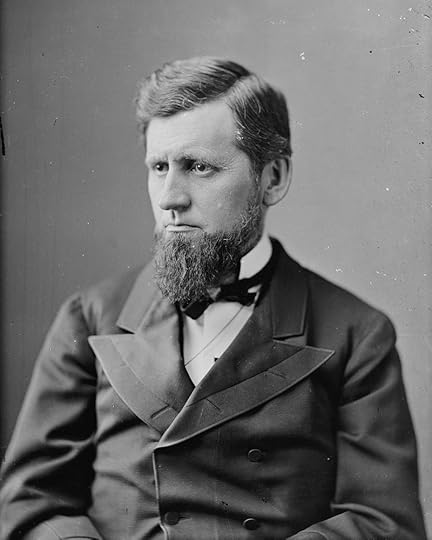
William Boyd Allison (March 2, 1829 – August 4, 1908) was an early leader of the Iowa Republican Party, who represented northeastern Iowa for four consecutive terms in the U.S. House before representing his state for six consecutive terms in the U.S. Senate. He died soon after overcoming his principal hurdle to election for a record seventh term in the Senate.
Early life and career
Born in Perry, Ohio, Allison was educated at Wooster Academy. Afterward, he spent a year at Allegheny College in Pennsylvania, then graduated from Western Reserve College (then located in Hudson, Ohio) in 1849. He then studied law and began practicing in Ashland, Ohio. While practicing law there from 1852 until 1857, he was a delegate to the 1855 Ohio Republican Convention and an unsuccessful candidate for district attorney in 1856. In 1857, he moved to Dubuque, Iowa, which would serve as his hometown for the last fifty years of his life.
Civil War
After his arrival in Dubuque, Allison took a prominent part in the politics of the nascent Republican Party. Allison was a delegate to the 1860 Republican National Convention in Chicago, which nominated Abraham Lincoln for President of the United States.
During the subsequent Civil War, he was on the staff of Iowa Governor Samuel J. Kirkwood, who ordered him to help the state raise regiments for the war. He personally helped raise four regiments. He was given the rank of lieutenant colonel during the war, although it was unlikely he actually served in uniform.
In 1862, in the midst of the war, Allison was elected to the United States House of Representatives as the representative of Iowa's newly created 3rd congressional district. As a congressman and member of the House Ways and Means Committee, he pushed for higher tariffs.
Post-war political career

Portrait of Senator Allison which hangs in the U.S. Capitol.
Following the war, Allison continued to serve in the House after winning re-election in 1866 and 1868. In January 1870, he was an unsuccessful candidate for election by the Iowa General Assembly to the United States Senate seat for 1871–1877, losing to Iowa Supreme Court Justice George G. Wright. Allison declined to be a candidate for renomination to his own House seat later that year, but instead focused on laying the groundwork to run for Iowa's other Senate seat (then held by James Harlan), which was up in January 1872, following November 1871 state legislative races. In the 1871 state legislative races, candidates were nominated and elected on the direct issue of whether they would vote for Harlan, Allison or James F. Wilson for senator. Enough legislators who favored Allison were nominated and elected in 1871 that in January 1872 he won the required number of votes to take Harlan's U.S. Senate seat, effective March 4, 1873.
Allison was reelected to six-year terms in the U.S. Senate six times — in 1878, 1884, 1890, 1896, and 1902.
Allison chaired the 1884–1886 Allison Commission, a bipartisan joint congressional committee "among the first to explore the question of whether federal intervention politicizes scientific research." It considered the charge that parts of the government were engaged in research for theoretical, not practical, purposes. The majority report favored the status quo, and Congress upheld it. In 1885, the Commission's finding of misuse of funds at the U.S. Coast and Geodetic Survey led to the dismissal of several officials but exonerated Charles Sanders Peirce.
As Allison earned seniority, he also earned one of the most powerful committee positions. From 1881–93 and again from 1895 to 1908, he was chairman of the Senate Appropriations Committee, where he had great influence. Allison's combined years as chairman of the committee make him the longest-serving chairman to date. He was also a member of the Senate Committee of Indian Affairs (and its chairman from 1875 to 1881), the Senate Finance Committee, and the Committee on Engrossed Bills. He became chairman of the Senate Republican Conference in 1897.
He was twice asked to serve as the Secretary of the Treasury, first by President Chester Arthur (to which Allison agreed but then the next day declined), then by President Benjamin Harrison. In 1897, President William McKinley offered him the position of U.S. Secretary of State. Again, Allison declined.
It was just as well. No Republican senator was so well fitted for the duties of responsible statesmanship, or positioned so well. For thirty years he sat on the Senate Finance Committee and took a critical role in framing legislation. In 1881, he became chairman of the Appropriations Committee, and continued to serve there until his death in 1908. After 1897, he was chosen as chairman of the Republican caucus, an unofficial position, but one generally accorded to the most venerable and respected party member in the Senate.
Eminently conservative, trusted by the railroad interests, Allison's pragmatism made him the centrist that everybody could deal with, even the Democrats. When in 1888 a Republican alternative was needed to the Mills tariff bill coming out of the House, Allison handled the details. The bill that emerged from committee was purely for campaign purposes. Nobody thought that it could pass, but it put the best face on protectionist principles and later served as a model for the 1890 McKinley Tariff, which Allison played a large part in framing. In 1897, when the Dingley Tariff bill reached the Senate, Allison did most of the work reconciling discontented interests. When the Bland bill, allowing the free coinage of silver, came to the Senate, Allison altered it. The resulting Bland-Allison Act of 1878 simply had the government buy a certain, more limited amount of silver, which the Treasury was permitted to put into circulation as silver dollars. It was far less inflationary than Bland's original bill. The Act passed over the veto of President Rutherford B. Hayes. It remained unchanged until the Sherman Silver Purchase Act of 1890. In 1892, Allison chaired the Brussels Monetary Conference and in 1900 was one of the fathers of the Gold Standard Act.
In 1896, he became a dark-horse candidate for the presidency. However, support for his candidacy faded when it became clear that McKinley would be nominated on the first ballot.
"Allison is the man of experience," an admiring reporter wrote in 1906, "the sage old pilot of the Senate. They say that no man who has ever been in the Senate knew so much about it as he does. He is the political forecaster, the compromiser, the weather prophet, the man who brings irreconcilable things together. It is said that the oldest inhabitant cannot recall having heard Allison give utterance to an opinion on any subject whatever. Doubtless he does give utterance to them, but never except in the inner councils of the Caesars. Sagacious to the point of craft, it does not annoy him to know that the epithet most frequently applied to him is 'the Old Fox.'... When he rises in his place in the Senate, he disdains to talk as if he were making a speech; he leaves all that to the youngsters, whose sum of knowledge does not equal all that he has forgotten. He never rises except to shed light on some knotty point, and when he does it is always as briefly as possible, and in a conversational voice that is almost an undertone. Then he drops back into his seat and, with sublime indifference, lets the talk go on."
The 1908 Senate race
In 1908, as Allison neared his 44th year in Congress, and his 80th birthday, he sought a record seventh term in the Senate. However, Iowa's Republican Governor at the time, Albert B. Cummins, had aspired to become a U.S. Senator for several years, and as leader of Republican progressives had targeted his party's "old guard" for retirement or (if necessary) defeat. After seeming to promise that he would not challenge Allison in 1908, Cummins ran against Allison for the Republican nomination in the state's first-ever congressional primary on June 2, 1908. Much like Allison's 1873 race for the Senate against incumbent Harlan, Cummins' 1908 race for the Senate against incumbent Allison was very acrimonious. However, this time the incumbent prevailed; Allison won a clear victory over Cummins by over ten thousand votes. As a reflection of the nature of its preference for Allison over Cummins, the Ames Times reported the primary results under a two-level banner headline simply stating "GLORY TO GOD!"
Death and his legacy
Allison did not live to see the 1908 general election or a seventh term. Two months after his primary win, he died in Dubuque. While many were surprised by his death, news reports soon indicated that he had been under constant medical care for more than two years, and that those familiar with his condition had expected his death. He was interred in Linwood Cemetery in Dubuque.
Governor Cummins was elected by the Legislature to fill the unexpired term of Senator Allison and for the term beginning March 4. 1909, and was re-elected in 1914 and 1920, but in 1926 he lost in the Republican primary to Smith W. Brookhart. Senator Cummins died shortly after his loss in the June 1926 primary.
The Allison-Henderson Park in Dubuque was named in honor of Allison and fellow Dubuque icon, U.S. Speaker of the House David B. Henderson.
There is an imposing memorial to Allison by sculptor Evelyn Longman on the grounds of the Iowa State Capitol in Des Moines. (Source: Wikipedia)
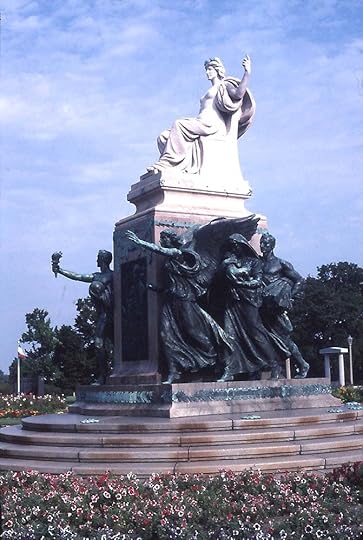
Sen. William Boyd Allison Monument, Des Moines, Iowa 1916
More:
http://www.encyclopedia.com/topic/Bla...
https://commons.wikimedia.org/wiki/Fi...
http://bioguide.congress.gov/scripts/...
http://www.encyclopediadubuque.org/in...
http://www.senate.gov/artandhistory/h...
http://dsmpublicartfoundation.org/pub...
(no image) Report of the Commissioners on Behalf of the United States, and Journal of the Sessions of November 22, 1892 to December 17, 1892 by William Boyd Allison (no photo)
(no image) William Boyd Allison (Late a Senator from Iowa) Memorial Addresses, Sixtieth Congress, Second Session. Senate of the United States, February 6, 1909 by United States Congress Memorial Addres (no photo)
(no image) Report of the Joint Select Committee of Congress Appointed to Inquire Into the Affairs of the Government of the District of Columbia: Together With, the Journal of the Committee, Answer of the Governor, Charges, Arguments, and Testimony by United States Congress Joint Select Co (no photo)
 by
by
 David McCullough
David McCullough by
by
 Karl Rove
Karl Rove
 James Madison
James Madison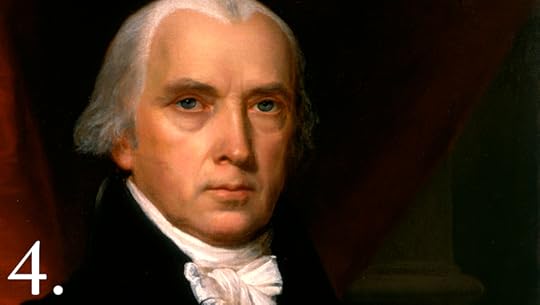
James Madison, America's fourth President (1809-1817), made a major contribution to the ratification of the Constitution by writing The Federalist Papers, along with Alexander Hamilton and John Jay. In later years, he was referred to as the "Father of the Constitution."
At his inauguration, James Madison, a small, wizened man, appeared old and worn; Washington Irving described him as "but a withered little apple-John." But whatever his deficiencies in charm, Madison's ... wife Dolley compensated for them with her warmth and gaiety. She was the toast of Washington.
Born in 1751, Madison was brought up in Orange County, Virginia, and attended Princeton (then called the College of New Jersey). A student of history and government, well-read in law, he participated in the framing of the Virginia Constitution in 1776, served in the Continental Congress, and was a leader in the Virginia Assembly.
When delegates to the Constitutional Convention assembled at Philadelphia, the 36-year-old Madison took frequent and emphatic part in the debates.
Madison made a major contribution to the ratification of the Constitution by writing, with Alexander Hamilton and John Jay, the Federalist essays. In later years, when he was referred to as the "Father of the Constitution," Madison protested that the document was not "the off-spring of a single brain," but "the work of many heads and many hands."
In Congress, he helped frame the Bill of Rights and enact the first revenue legislation. Out of his leadership in opposition to Hamilton's financial proposals, which he felt would unduly bestow wealth and power upon northern financiers, came the development of the Republican, or Jeffersonian, Party.
As President Jefferson's Secretary of State, Madison protested to warring France and Britain that their seizure of American ships was contrary to international law. The protests, John Randolph acidly commented, had the effect of "a shilling pamphlet hurled against eight hundred ships of war."
Despite the unpopular Embargo Act of 1807, which did not make the belligerent nations change their ways but did cause a depression in the United States, Madison was elected President in 1808. Before he took office the Embargo Act was repealed.
During the first year of Madison's Administration, the United States prohibited trade with both Britain and France; then in May, 1810, Congress authorized trade with both, directing the President, if either would accept America's view of neutral rights, to forbid trade with the other nation.
Napoleon pretended to comply. Late in 1810, Madison proclaimed non-intercourse with Great Britain. In Congress a young group including Mb>Henry Clay and John C. Calhoun, the "War Hawks," pressed the President for a more militant policy.
The British impressment of American seamen and the seizure of cargoes impelled Madison to give in to the pressure. On June 1, 1812, he asked Congress to declare war.
The young Nation was not prepared to fight; its forces took a severe trouncing. The British entered Washington and set fire to the White House and the Capitol.
But a few notable naval and military victories, climaxed by Gen. Andrew Jackson's triumph at New Orleans, convinced Americans that the War of 1812 had been gloriously successful. An upsurge of nationalism resulted. The New England Federalists who had opposed the war--and who had even talked secession--were so thoroughly repudiated that Federalism disappeared as a national party.
In retirement at Montpelier, his estate in Orange County, Virginia, Madison spoke out against the disruptive states' rights influences that by the 1830's threatened to shatter the Federal Union. In a note opened after his death in 1836, he stated, "The advice nearest to my heart and deepest in my convictions is that the Union of the States be cherished and perpetuated." (Source: White House.gov

Montpelier restored to its original state
More:
https://www.montpelier.org/
https://en.wikipedia.org/wiki/James_M...
http://www.biography.com/people/james...
http://www.history.com/topics/us-pres...
https://www.montpelier.org/james-and-...
http://www.britannica.com/biography/J...
http://www.jamesmadison.gov/
 by Richard Brookhiser (no photo)
by Richard Brookhiser (no photo) by Ralph Louis Ketcham (no photo)
by Ralph Louis Ketcham (no photo) by Richard Labunski (no photo)
by Richard Labunski (no photo) by
by
 Lynne Cheney
Lynne Cheney by
by
 Kevin R.C. Gutzman
Kevin R.C. Gutzman by
by
 James Madison
James Madison by
by
 Alexander Hamilton,
Alexander Hamilton,
 James Madison, and
James Madison, and
 John Jay
John Jay
 John Dickinson
John Dickinson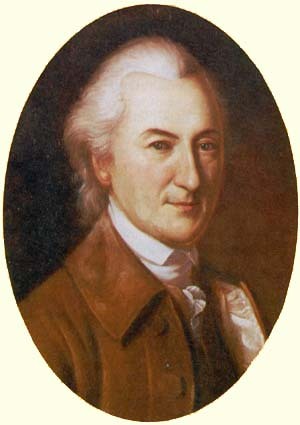
Often referred to as the "penman of the Revolution," John Dickinson was an American statesman, delegate to the Continental Congress and one of the writers of the Articles of Confederation.
Synopsis
John Dickinson was born in 1732 and won fame in 1767 as the author of "Letters from a Farmer in Pennsylvania, to the Inhabitants of the British Colonies." The letters helped turn public opinion against the Townshend Acts, enacted by the British Parliament. Dickinson also helped draft the Articles of Confederation and craft the U.S. Constitution. His legacy is honored through Dickinson College and Penn State's Dickinson School of Law, both in Carlisle, Pennsylvania.
Early Years
John Dickinson was born in 1732 to a wealthy Quaker family in Maryland. Six years later, the family moved to an estate in Delaware. At age 18, Dickinson followed his father, a judge in Delaware, into the study of law at a Philadelphia law office. In 1753, Dickinson went overseas and spent four years studying in the London court system. While there, he heard leading minds of the day discuss Enlightenment philosophy and individual rights. The experience brought into sharp focus the relationship between history and politics and would influence the rest of Dickinson's life.
Returning to Philadelphia in 1757 to practice law, John Dickinson saw his reputation in the legal field grow. Three years later, he made his first foray into politics and was soon elected to both the Delaware legislature and the Pennsylvania assembly (made possible by Dickinson's residency in both regions). In 1764, he challenged Benjamin Franklin on the issue of replacing Pennsylvania’s proprietary charter with a royal charter (Dickinson was against it). Dickinson lost both the debate and his assembly seat in Pennsylvania.
The Era of Discontent
In the aftermath of the Seven Years War (1756-1763), the British government found itself deep in debt and began looking for ways to generate revenue. Parliament enacted the Stamp Act of 1765, which imposed a direct tax on specific products imported to the colonies. Predictably, the colonists met the tax with fierce opposition claiming taxation without representation and organizing boycotts on British goods.
John Dickinson, with his strong, measured voice, was chosen to represent Pennsylvania at the Stamp Act Congress in 1765, where he drafted the body's anti–Stamp Act resolution. Though Parliament repealed the Stamp Act in 1766, it ignored the colonists’ protests and passed the Townshend Acts of 1767, which imposed new taxes on goods imported to the colonies. Soon after, Dickinson began publishing in the Pennsylvania Chronicle his "Letters from a Farmer in Pennsylvania to the Inhabitants of the British Colonies" under the pseudonym "Fabius." The letters advocated peaceful resistance to oppression and warned against revolution as an answer to Britain’s violations. The letters were republished in many colonial newspapers advocating a cautious opposition to British tyranny.
Declaration of Independence and the U.S. Constitution
After serving in various roles, including battle during the Revolutionary War, John Dickinson was elected to the Delaware legislature and was later elected governor. During the Second Continental Congress, there was high tension among the delegates and intense debate over revolution, but Dickinson refused to vote for or sign the Declaration of Independence, saying the emerging nation was not ready for open revolt against the most powerful empire on earth. In the end, he abstained from voting so that the overall tally for independence would be unanimous.
In 1779, after the Revolutionary War, in which he fought in varying roles, Dickinson served in the Confederation Congress and was elected president of Delaware two years later (in 1782 he was elected Pennsylvania president). In 1786, he chaired the Annapolis Convention, convened to address concerns over the Articles of Confederation. The next year, Dickinson represented Delaware at the Constitution Convention, in Philadelphia. Unfortunately, illness kept Dickinson from signing the document, and a colleague put his name to the parchment.
Final Years
John Dickinson returned to Delaware where he divided his time between private life and political duty. He served as president of Delaware’s constitutional convention and was an informal advisor to President Thomas Jefferson. Dickinson died on February 14, 1808, at his home in Wilmington, Delaware. (Source: Biography.com)
More:
https://en.wikipedia.org/wiki/John_Di...
http://www.let.rug.nl/usa/biographies...
http://www.history.army.mil/books/rev...
http://teachingamericanhistory.org/st...
http://www.historynet.com/the-patriot...
(no image) John Dickinson, Conservative Revolutionary by Milton E. Flower (no photo)
(no image) John Dickinson Sounds the Alarm, by Florence D. Scull (no photo)
 by Jane E. Calvert (no photo
by Jane E. Calvert (no photo by Paul Leicester Ford (no photo)
by Paul Leicester Ford (no photo) by William Murchison (no photo)
by William Murchison (no photo) by
by
 John Dickinson
John Dickinson by
by
 John Dickinson
John Dickinson
 Henry B. Anthony
Henry B. Anthony
Henry Bowen Anthony (April 1, 1815 – September 2, 1884) was a United States newspaperman and political figure. He served as editor and was later part owner of the Providence Journal. He was the 21st Governor of Rhode Island, serving between 1849 and 1851 as a member of the Whig Party. Near the end of the 1850s, he was elected to the Senate by the Rhode Island Legislature and was re-elected 4 times. He would be twice elected to the Senate's highest post as President pro tempore during the Grant Administration, and served under his death in 1884.
Career
He became editor of the Providence Journal in 1838. In 1840, he was admitted into the partnership, the paper then being published by Knowles, Vose & Anthony until the death of Vose in 1848, when it was continued by Knowles & Anthony until 1863, when it became Knowles, Anthony & Danielson. Anthony also wrote poetry.
As editor of the Journal, Anthony was a conservative, supporting law and order, property requirements for voting, and restrictions on the political power of immigrants. In 1849, and again in 1850, he was elected governor of Rhode Island. As a Whig at the first election he had a majority of 1,556; at the second, fewer than 1,000 votes were cast against him. After declining a third election, he gave himself once more entirely to his editorial work.
In 1855, he traveled in Europe, sending letters with unfavorable observations back to the Journal. On returning, he joined the Know Nothing movement and used the Journal to back its American Party. In Rhode Island, the American Party merged into the Republican Party, and Anthony was elected to the United States Senate as an “American-Republican.”
United States Senator
Anthony served as a Republican Senator from Rhode Island from March 4, 1859, until his death on September 2, 1884. Initially conciliatory toward the secessionists, he was a strong supporter of Abraham Lincoln's efforts to restore the Union during the American Civil War. After the war, in recognition of his support for the Union, he was elected a third class (i.e. honorary) companion of the District of Columbia Commandery of the Military Order of the Loyal Legion of the United States.
He was twice the chairman of the committee on printing, his practical knowledge of that subject enabling him to introduce many reforms in government printing. The Government Printing Office was formed during his tenure. He was at different times a member of the committees on claims, on naval affairs, on mines and mining, and on post offices and post roads. In the trial of Andrew Johnson, he voted for impeachment. He continued to contribute to the Providence Journal during his service in the Senate.
He served as the President pro tempore of the United States Senate from 1869 to 1873 and again briefly in 1875. He gave up that post when he was elected conference chairman in 1875. As chair, Anthony acted much like the later majority leaders, giving committee assignments to members of his party, calling up bills for debate, and often speaking for his party on the issues of the day. He was also the author of the "Anthony Rule," an early attempt to limit debate in the Senate in the days before cloture. He was known as the "Father of the Senate".
Death and legacy
Anthony's funeral, which took place from the First Congregational Church in Providence on 6 September, 1884 was the largest funeral ever known in Rhode Island.
Anthony bequeathed a portion of his library, known as the “Harris Collection of American Poetry,” to Brown University. It consisted of about 6,000 volumes, mostly small books, many exceedingly rare. It was begun in the first half of the 19th century by Albert G. Greene, continued by Caleb Fiske Harris, and, after his death, completed by his kinsman Senator Anthony.
His name is engraved on a Civil War vintage artillery piece belonging to the Squantum Club in East Providence, Rhode Island. The artillery piece is reputed to have been the only gun from Battery A, 1st Rhode Island Light Artillery which did not fall into Confederate hands at the Battle of Bull Run. There is another nearly identical piece, known as the "Bull Run Gun", enshrined at the Rhode Island State House for which is claimed the same distinction. (Source: Wikipedia)
More:
http://www.senate.gov/artandhistory/h...
http://www.senate.gov/artandhistory/h...
http://bioguide.congress.gov/scripts/...
http://www.findagrave.com/cgi-bin/fg....
http://www.warwickhistory.com/index.p...
 by Thomas Davis (no photo)
by Thomas Davis (no photo) by John L. Myers (no photo)
by John L. Myers (no photo) by Henry Bowen Anthony (no image)
by Henry Bowen Anthony (no image) by Rhode Island. General Assembly (no photo)
by Rhode Island. General Assembly (no photo) by Henry Bowen Anthony (no photo)
by Henry Bowen Anthony (no photo)
 Ambrose Burnside
Ambrose Burnside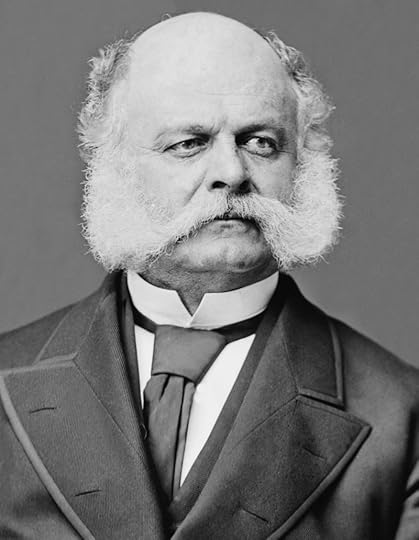
Ambrose Burnside is best known for his leadership as a major general of the Union army in the Civil War and for originating the fashion of sideburns in the United States.
Synopsis
Born in Indiana in May 1824, Ambrose Burnside was a Union major general in the American Civil War and father of "side whiskers," later known as sideburns.
Early Years
The son of a court clerk and farmer, Ambrose Burnside was born near Liberty, Indiana, on May 23, 1824. With the help of his father, Burnside received an appointment to the United States Military Academy at West Point in 1843, but he had a hard time adjusting to his new, regimented life and came close to being expelled several times. He was a good student, however, and despite his troubles with assimilation, Burnside graduated in 1847, 18th in his class of 38 students.
Out of the academy, Burnside was commissioned a brevet second lieutenant in the 2nd Artillery and served during the Mexican-American War. After the war, in 1853, he resigned his commission and founded Bristol Rifle Works, a company that produced breech-loading rifles. The business failed, and Burnside headed back into the military, this time as a major general of the Rhode Island militia.
Civil War
When the Civil War began, Burnside led the Rhode Island Infantry to Washington and was charged with protecting the city. Then, in 1861, Burnside commanded a contingent of infantry during the first battle of Manassas and afterward was made a brigadier general of volunteers for his actions. He took charge of the North Carolina Expeditionary Force, comprising three brigades, and he and his men dug in and established a foothold in North Carolina. The success of the mission provide Burnside with his next rung up the military ladder, as he was soon promoted to major general of volunteers in March 1862.
At the battle of Antietam, Burnside was assigned command of more troops by Union general George McClellan, and by November, Burnside was made commander of the Army of the Potomac. A month later, though, Confederate general Robert E. Lee and the Army of Northern Virginia soundly defeated Burnside and his troops at the Battle of Fredericksburg, a hugely lopsided defeat that resulted in more than 13,000 Union deaths.
Soon after, Burnside was relieved of command, but by September of that year, Burnside was again making a difference in the war effort, defeating Confederate general James L. Longstreet and holding Knoxville, Tennessee, until William Sherman and Union reinforcements arrived and forced Longstreet into retreat.
Knoxville put Burnside back in the good graces of his commanders, and he was given command of more troops in support of the Army of the Potomac. Under General Ulysses S. Grant, Burnside participated in the Overland campaign, which included the battles of the Wilderness, Spotsylvania Court House, and Cold Harbor.
His undoing, however, was waiting at the battle of Crater. Burnside had his men fill a Union mine lying under Confederate positions with explosives and detonate them. The explosion divided Confederate troops as planned, but Burnside was slow to exploit the move and Union soldiers were lost. In the aftermath, in April 1865, Burnside resigned his commission.
Postwar and Legacy
In April 1866, Burnside was elected governor of Rhode Island, and he served three one-year terms. He then headed to Washington to represent Rhode Island in the U.S. Senate, but a year into his second term, on September 13, 1881, Burnside died of heart disease.
Beyond his battlefield exploits, Ambrose Burnside is remembered for his distinctive facial hair,a style now known as sideburns, which took its name from Burnside’s own last name. (Source: Biography.com)
More:
https://en.wikipedia.org/wiki/Ambrose...
http://www.civilwar.org/education/his...
http://www.history.com/topics/america...
http://www.historynet.com/ambrose-bur...
http://www.civilwarhome.com/burnbio.html
http://militaryhistory.about.com/od/a...
 by Augustus Woodbury (no photo)
by Augustus Woodbury (no photo) by Various (no photo)
by Various (no photo) by John D. Fuller (no photo)
by John D. Fuller (no photo) by Ned Bradford (no photo)
by Ned Bradford (no photo) by James Robertson (no photo)
by James Robertson (no photo)
 American Sugar Refining Company, The Sugar Trust
American Sugar Refining Company, The Sugar TrustThe American Sugar Refining Company (ASR) was the largest American business unit in the sugar refining industry in the early 1900s. It had interests in Puerto Rico and other Caribbean locations, and operated one of the world's largest sugar refineries located in Brooklyn, New York.
Establishment
The ASR was incorporated in the state of New Jersey on January 10, 1891, with $50 million in capital. By 1907, it owned or controlled 98% of the sugar processing capacity in the United States and was known as the Sugar Trust.
The United States Supreme Court declared in United States v. E. C. Knight Company that its purchase of the stock of competitors was not a combination in restraint of trade. By 1901, the company had $90 million in capital. The company became known as Domino Sugar in 1900.
Expansion
The combination expanded horizontally for about twenty years as new competitors arose; later it expanded vertically, undertaking the production of cane sugar and raw sugar in Cuba and acquiring lumber interests. The company was investigated by the Industrial Commission in 1900 and by a special congressional committee in 1911–1912.
In 1910 the federal government began a suit for the company's dissolution. This was terminated by consent decree announced December 21, 1921, when Domino Sugar stated that its effective control of refined sugar had dropped from 72% to 24%.
According to the Encyclopedia of New York City, "the struggle ended with a settlement in 1922 that allowed the firm to remain intact but forced it to refrain from unfair business practices, and as competition revived, the firm ceased to dominate the industry". After the Great Depression, the sugar refining industry declined as alternatives to sugar and modern technology were introduced.
American Sugar Refining Company continued to dominate the sugar industry in the United States through most of the 20th Century. Its brands included the dominant Domino Sugar, Franklin Sugar, Sunny Cane Sugar, and its West Coast beet sugar operation under the Spreckels brand. It had major refineries in Brooklyn, Bunker Hill, Massachusetts;, Philadelphia, Baltimore, Chalmette, Louisiana; and Spreckels, California.
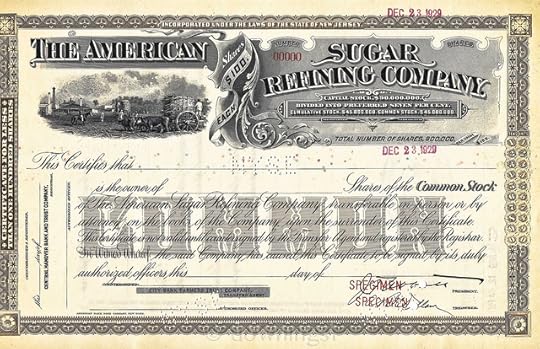
A 1929 specimen stock certificate given as a reference copy to the NYSE
Name change and takeover
In the early 1970s, the company made major investments in high-fructose corn syrup production, and changed its name to Amstar Corporation (ASR). It moved its headquarters from 120 Wall Street to 1251 Avenue of the Americas (6th Avenue) (The Exxon Building) in mid-town Manhattan.
With investments in food-picking and handling machinery companies in the Midwestern United States, the company faced a takeover by the British sugar company Tate & Lyle in 1980. How long this lasted is uncertain since American Sugar is now part of another group.
The Domino brand name is currently associated with a company that also owns two of its former major competitors, C&H Sugar (California and Hawaii) and Jack Frost (National Sugar Company). (Source: Wikipedia)
More:
https://en.wikipedia.org/wiki/Henry_O...
http://www.nyfoodmuseum.org/sugar.htm
http://www.brooklynpaper.com/stories/...
http://www.jstor.org/stable/724757?se...
http://www.brooklyneagle.com/articles...
(no image) Report to the Committee on General Laws Relative to Trusts and Sugar Trusts. by New York (State) Legislature Senate C (no photo)
 by American sugar refining company
by American sugar refining company by United States. Congress. House. Special Committee on Investigation of American Sugar Refining Compan (no photo)
by United States. Congress. House. Special Committee on Investigation of American Sugar Refining Compan (no photo) by Robert Harrison (no photo)
by Robert Harrison (no photo) by Frank William Taussig (no photo)
by Frank William Taussig (no photo)
 Thaddeus Mahon, President of Baltimore and Cumberland Valley Railroad
Thaddeus Mahon, President of Baltimore and Cumberland Valley Railroad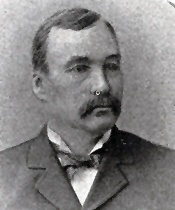
Thaddeus Maclay Mahon (May 21, 1840 – May 31, 1916) was a soldier, attorney, railroad executive, and a Republican member of the U.S. House of Representatives from Pennsylvania.
Thaddeus M. Mahon was born in rural Green Village, Pennsylvania. During the American Civil War, he enlisted in August 1862 as a private in Company A, One Hundred and Twenty-sixth Regiment of the Pennsylvania Volunteers. After a term of service in this regiment, he reenlisted as a veteran in January 1864 in the Twenty-first Regiment, Pennsylvania Volunteer Cavalry, and served until September 1865.
Mahon studied law, was admitted to the bar in 1871, and commenced practice in southern Pennsylvania. He served as a member of the Pennsylvania State House of Representatives from 1870 to 1872. He was the president of Baltimore & Cumberland Valley Railroad. He was also a member of the commission having charge of the soldiers’ orphan schools of Pennsylvania. He was an unsuccessful candidate for election in 1876.
Mahon was elected as a Republican to the Fifty-third and to the six succeeding Congresses. He served as chairman of the United States House Committee on War Claims during the Fifty-fourth through the Fifty-ninth Congresses. He was not a candidate for renomination in 1906. He was engaged in business in Chambersburg, Pennsylvania.
He died in Scotland, Pennsylvania, in 1916. Interment was in Cedar Grove Cemetery in Chambersburg. (Source: Wikipedia)
More:
https://www.govtrack.us/congress/memb...
http://www.pacivilwar.com/bios/mahon_...
http://military.wikia.com/wiki/Thadde...
http://www.wikiwand.com/en/Thaddeus_M...
https://en.wikipedia.org/wiki/Cumberl...
(no image) American Civil War: Support Services of the Union Army Volume 2 by Rodger Woltjer (no photo)
 by Robert Harrison (no photo)
by Robert Harrison (no photo) by David Watson Rowe (no photo)
by David Watson Rowe (no photo) by Mary H Rubin (no photo)
by Mary H Rubin (no photo) by Richard B. Irwin (no photo)
by Richard B. Irwin (no photo)
 Stephen Benton Elkins
Stephen Benton Elkins
Stephen Benton Elkins (September 26, 1841 – January 4, 1911) was an American industrialist and political figure. He served as the Secretary of War between 1891 and 1893. He served in the Congress as a Delegate from the Territory of New Mexico and a Senator from West Virginia.
Early life
Elkins was born near New Lexington, Ohio and moved with his family to Westport, Missouri (now part of Kansas City) in the mid-1840s to Philip Duncan Elkins and Sarah Pickett Withers. He attended the Masonic College in Lexington, Missouri in the 1850s, and graduated from the University of Missouri in Columbia in 1860. After graduation, he briefly taught school in Cass County, Missouri. Among his pupils was future James-Younger Gang member Cole Younger.
Civil War
In the American Civil War Elkins' father and brother joined the Confederate Army under Sterling Price, but he joined the Union Army. Before he joined the Union Army he was to encounter Quantrill's Raiders twice and was spared from being killed because of his father and brother. He noted:
They marched me along and we got to Quantrill's camp. There I saw Cole Younger, Dick Yager and George M. Todd, and several others afterward known for desperate deeds. Those I have mentioned were farmers' sons around where I lived. They identified me and said: Here comes Steve Elkins. All the way along I had been afraid that those fellows who had captured me would shoot me in the back, for I had on the watch which I am carrying now in the office of the secretary of war.
Elkins entered the Union Army as a captain of militia in the 77th Missouri Infantry. He served under Kersey Coates and only saw action once in the Battle of Lone Jack, which he said filled him with disgust for war. Elkins noted that his good fortune of being protected by Quantrill matched a fear of being butchered by Quantrill for becoming a Union soldier as Quantrill's Raiders were thought to be present at the battle.
New Mexico
He entered the practice of law at Mesilla, New Mexico, and was elected to the territorial legislature in 1864 and 1865. He was appointed territorial district attorney for a term from 1866 to 1867. It was at this time, on June 10, 1866, that he married his first wife Sarah Simms Jacobs.
In 1867, Elkins served as attorney general of the territory and later as U.S. district attorney from 1867 to 1870. He was elected territorial delegate to the U.S. Congress in 1872, and reelected in 1874, serving from March 4, 1873 to March 4, 1877. In 1875, he met and married his second wife, Hallie Davis, and continued to practice law. He founded and was president of the Santa Fe National Bank, and pursued broad business interests in land, rail, mining, and finance including president of the massive Maxwell Land Grant Company. In attempting to evict "squattors" (legitimate land grant heirs) from the Land Grant he would be accused of being part of the Santa Fe Ring. Along with his brother in law, Thomas B. Catron, Elkins participated in what would become the largest land speculation conspiracy in U.S. history. Using his influence on politicians such as congressmen, territorial judges, and U.S. Surveyors General, Elkins was able to patent Spanish and Mexican land grants in his name, thereby illegally including himself as a legitimate heir to the grants. By collectively representing opposing parties in land disputes, Elkins and Catron effectively manipulated territorial government policy to illegally partition Spanish and Mexican land grants, a direct violation of the Treaty of Guadalupe Hidalgo.
West Virginia
Around 1890, he moved to Elkins, West Virginia, a town he had founded earlier, to pursue coal and rail interests. By 1892, the Davis Coal and Coke Company, a partnership between Elkins and his father-in-law, Senator Henry G. Davis, was among the largest coal companies in the world.
Secretary of War
Elkins served as Secretary of War in the Benjamin Harrison administration from December 17, 1891 to March 5, 1893. Amongst his goals were that the rank of lieutenant general be revived, and also that noncommissioned officers receive higher pay to improve the quality of the service. He also broadened the intelligence functions of the Division of Military Information.
U.S. Senator
After his service as Secretary, he was elected to the U.S. Senate in 1895, serving the state of West Virginia, and was re-elected twice. In the Senate, he held the positions of chairman of the Committee on the Geological Survey (Fifty-sixth and Fifty-ninth Congresses), and of member of the Committee on Interstate Commerce (Fifty-seventh through Sixty-first Congresses). Elkins served as Senator until his death in Washington, D.C. in 1911, and is interred in Maplewood Cemetery of Elkins, West Virginia. (Source: Wikipedia)
More:
https://en.wikipedia.org/wiki/Senator...
http://bioguide.congress.gov/scripts/...
http://military.wikia.com/wiki/Stephe...
http://history.house.gov/People/Detai...
http://www.britannica.com/biography/S...
(no image) The Industrial Question in the United States: Address Delivered Before the Alumni Association of the University of the State of Missouri by Stephen Benton Elkins (no photo)
 by Anonymous (no photo)
by Anonymous (no photo) by Stephen Benton Elkins (no photo)
by Stephen Benton Elkins (no photo) by Stephen B. Elkins (no photo)Edmund Morris
by Stephen B. Elkins (no photo)Edmund Morris by
by

 John Pierpont "J.P." Morgan
John Pierpont "J.P." Morgan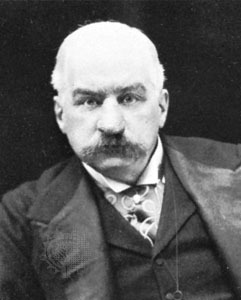
John Pierpont Morgan, byname J.P. Morgan (born April 17, 1837, Hartford, Connecticut, U.S.—died March 31, 1913, Rome, Italy)
American financier and industrial organizer, one of the world’s foremost financial figures during the two pre-World War I decades. He reorganized several major railroads and consolidated the United States Steel, International Harvester, and General Electric corporations.
The son of a successful financier, Junius Spencer Morgan (1813–90), John Pierpont was educated in Boston and at the University of Göttingen. He began his career in 1857 as an accountant with the New York banking firm of Duncan, Sherman and Company, which was the American representative of the London firm George Peabody and Company. In 1861 Morgan became the agent for his father’s banking company in New York City. During 1864–71 he was a member of the firm of Dabney, Morgan and Company, and in 1871 he became a partner in the New York City firm of Drexel, Morgan and Company, which soon became the predominant source of U.S. government financing. This firm was reorganized as J.P. Morgan and Company in 1895, and, largely through Morgan’s ability, it became one of the most powerful banking houses in the world.
Because of his links with the Peabody firm, Morgan had intimate and highly useful connections with the London financial world, and during the 1870s he was thereby able to provide the rapidly growing industrial corporations of the United States with much-needed capital from British bankers. He began reorganizing railroads in 1885, when he arranged an agreement between two of the largest railroads in the country, the New York Central Railroad and the Pennsylvania Railroad, that minimized a potentially destructive rate war and rail-line competition between them. In 1886 he reorganized two more major railroads with the aim of stabilizing their financial base. In the course of these corporate restructurings, Morgan became a member of the board of directors of these and other railroads, thereby amassing great influence on them. Between 1885 and 1888 he extended his influence to lines based in Pennsylvania and Ohio, and after the financial panic of 1893 he was called upon to rehabilitate a large number of the leading rail lines in the country, including the Southern Railroad, the Erie Railroad, and the Northern Pacific. He helped to achieve railroad rate stability and discouraged overly chaotic competition in the East. By gaining control of much of the stock of the railroads that he reorganized, he became one of the world’s most powerful railroad magnates, controlling about 5,000 miles (8,000 km) of American railroads by 1902.
During the depression that followed the panic of 1893, Morgan formed a syndicate that resupplied the U.S. government’s depleted gold reserve with $62 million in gold in order to relieve a Treasury crisis. Three years later he began financing a series of giant industrial consolidations that were to reshape the corporate structure of the American manufacturing sector. His first venture, in 1891, was to arrange the merger of Edison General Electric and Thomson-Houston Electric Company to form General Electric, which became the dominant electrical-equipment manufacturing firm in the United States. Having financed the creation of the Federal Steel Company in 1898, Morgan in 1901 joined in merging it with the giant Carnegie Steel Company and other steel companies to form United States Steel Corporation, which was the world’s first billion-dollar corporation. In 1902 Morgan brought together several of the leading agricultural-equipment manufacturers to form the International Harvester Company. In that same year he organized, with less subsequent success, the International Mercantile Marine (IMM), an amalgamation of a majority of the transatlantic shipping lines, notably including White Star. In April 1912 Morgan had a booking on the maiden voyage of White Star’s Titanic but was forced to cancel, reportedly because of an illness. The ship subsequently sank with great loss of life.
Morgan successfully led the American financial community’s attempt to avert a general financial collapse following the stock market panic of 1907. He headed a group of bankers who took in large government deposits and decided how the money was to be used for purposes of financial relief, thereby preserving the solvency of many major banks and corporations. Having ceased to undertake large industrial reorganizations, Morgan thereafter concentrated on amassing control of various banks and insurance companies. Through a system of interlocking memberships on the boards of companies he had reorganized or influenced, Morgan and his banking house achieved a top-heavy concentration of control over some of the nation’s leading corporations and financial institutions. This earned Morgan the occasional distrust of the federal government and the enmity of reformers and muckrakers throughout the country, but he remained the dominant figure in American capitalism until his death in 1913.
Morgan was one of the greatest art and book collectors of his day, and he donated many works of art to the Metropolitan Museum of Art in New York City. His book collection and the building that housed them in New York City became a public reference library in 1924. (Source: Encyclopedia Britannica)
The House of Morgan

The building at 23 Wall Street was built as the headquarters of JP Morgan & Co but its ownership is now tied to Sam Pa, a jet-setting Hong Kong-based businessman with seven names. Photograph: Alamy (Source: The Guardian)
On Junius’ death in 1890, Pierpont Morgan took his place at J.S. Morgan and Company. After Drexel’s death, Drexel, Morgan reorganized in 1895 and became J.P. Morgan and Company, eventually becoming one of the most powerful banking companies in the world and helping to transform the United States from an economic novice into the strongest industrial power in the world at that time.
It financed the formation of the United States Steel Corporation, which took over the business of Andrew Carnegie and others and was the world's first billion-dollar corporation. In 1895, it supplied the United States government with $62 million in gold to float a bond issue and restore the treasury surplus of $100 million. In 1892, the company began to finance the New York, New Haven and Hartford Railroad and led it through a series of acquisitions that made it the dominant railroad transporter in New England.
Built in 1914, 23 Wall Street was known as "The Corner" and "The House of Morgan," and for decades the bank's headquarters was the most important address in American finance. (Source: Wikipedia)
More:
http://www.biography.com/people/jp-mo...
http://www.history.com/topics/john-pi...
http://www.history.co.uk/biographies/...
https://www.jpmorgan.com/global/jpmor...
https://www.jpmorgan.com/country/US/E...
http://www.encyclopedia.com/topic/J.P...
http://www.pbs.org/wgbh/amex/1900/peo...
http://www.netstate.com/states/peop/p...
https://en.wikipedia.org/wiki/J._P._M...
http://www.theguardian.com/business/2...
(no imageMorgan the Magnificent by John Kennedy Winkler (no photo)
(no image)J. Pierpont Morgan: An Intimate Portrait by Herbert L. Satterlee (no photo)
 by Herbert H. Harwood Jr. (no photo)
by Herbert H. Harwood Jr. (no photo) by
by
 Jean Strouse
Jean Strouse by
by
 Louis Auchincloss
Louis Auchincloss by
by
 Frederick Lewis Allen
Frederick Lewis Allen by
by
 Ron Chernow
Ron Chernow
 Aldrich–Vreeland Act
Aldrich–Vreeland Act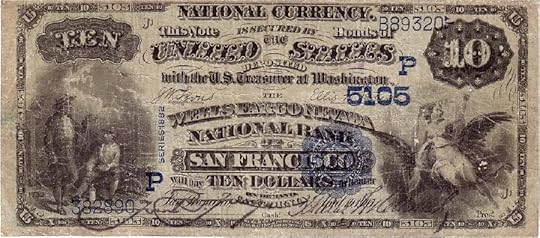
The Aldrich–Vreeland Act was passed in response to the Panic of 1907 and established the National Monetary Commission, which recommended the Federal Reserve Act of 1913.
On May 27, 1908, the bill passed the House on a mostly party-line vote of 166–140, with 13 Republicans voting against it and no Democrats voting for it. On May 30, it passed in the Senate with 43 Republicans in favor and five Republicans joining 17 Democrats opposed. President Roosevelt signed the bill that same night.
The act also allowed national banks to start national currency associations in groups of ten or more, with at least $5 million in total capital, to issue emergency currency. These bank notes were to be backed by not just government bonds but also just about any securities the banks were holding. The act proposed that this emergency currency had to go through a process of approval by the officers of these national currency associations and then distributed by the Comptroller of the Currency.
However, it is possible that because there was a 5 percent tax placed on this emergency currency for the first month it was "outstanding" and a 1 percent increase for the following months it was "outstanding," no bank notes were issued. Another possible explanation that the emergency currency was never issued might have been that it was unnecessary.
Congress modified and extended the law in 1914 when British and other foreign creditors demanded immediate payments, in gold, of amounts which would ordinarily have been carried over and paid through exports of commodities.
Senator Nelson W. Aldrich (R-RI) was largely responsible for the Aldrich-Vreeland Currency Law and became the Chairman of the National Monetary commission. The co-sponsor of the legislation was Rep. Edward Vreeland, a Republican from New York.
A usage of the law occurred at the outbreak of the World War I in 1914 when the first great financial panic of the 20th century befell the world, necessitating the closure of the New York Stock Exchange. Secretary of the Treasury William Gibbs McAdoo appeared in New York City and assured the public that ample stocks of emergency banknotes had been prepared in accordance with the Aldrich–Vreeland Act and were available for issue to the banks. As of October 23, 1914, $368,616,990 was outstanding.
The Federal Reserve Act of December 23, 1913 took effect in November 1914 when the 12 regional banks opened for business. Ultimately the emergency currency issued under the Aldrich-Vreeland Law was entirely withdrawn.
(Source: Wikipedia)
More:
http://www.encyclopedia.com/doc/1G2-3...
http://what-when-how.com/the-american...
http://www.u-s-history.com/pages/h953...
http://www.urbandictionary.com/define...
http://definitions.uslegal.com/a/aldr...
https://fraser.stlouisfed.org/scribd/...
https://rshih.gitbooks.io/money/conte...
https://mstartzman.pbworks.com/w/page...
http://query.nytimes.com/gst/abstract...
http://query.nytimes.com/gst/abstract...
http://query.nytimes.com/gst/abstract...
http://query.nytimes.com/gst/abstract...
http://query.nytimes.com/gst/abstract...
http://query.nytimes.com/gst/abstract...
https://archive.org/stream/jstor-1014...
http://query.nytimes.com/gst/abstract...
http://query.nytimes.com/gst/abstract...
http://archive.nyu.edu/bitstream/2451...
(no image)Banking Reform and the Federal Reserve, 1863-1923 by Robert Craig West (no photo)
(no image)American Monetary System by Robert A. Degen (no photo)
 by Elmus Wicker (no photo)
by Elmus Wicker (no photo) by Perry G. Mehrling (no photo)
by Perry G. Mehrling (no photo) by
by
 Milton Friedman
Milton Friedman
 Gross National Product - GNP
Gross National Product - GNP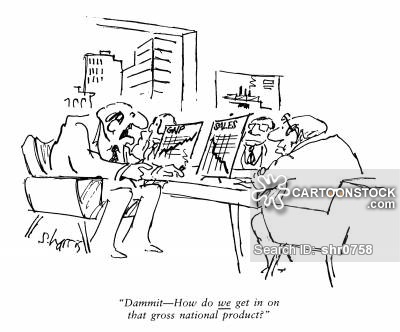
What is 'Gross National Product - GNP'
Gross national product (GNP) is an estimate of total value of all the final products and services produced in a given period by the means of production owned by a country's residents. GNP is commonly calculated by taking the sum of personal consumption expenditures, private domestic investment, government expenditure, net exports, and any income earned by residents from overseas investments, minus income earned within the domestic economy by foreign residents. Net exports represent the difference between what a country exports minus any imports of goods and services.
GNP is related to another important economic measure called gross domestic product (GPD), which takes into account all output produced within a country's borders regardless of who owns the means of production. GNP starts with GDP, adds residents' investment income from overseas investments, and subtracts foreign residents' investment income earned within a country.
BREAKING DOWN 'Gross National Product - GNP'
GNP measures the total monetary value of the total output produced by a country's residents. Therefore, any output produced by foreign residents within the country's borders must be excluded in calculations of GNP, while any output produced by the country's residents outside of its borders must be counted. GNP does not include intermediary goods and services to avoid double-counting since they are already incorporated in the value of final products and services.
The Difference Between GNP and GDP
GNP and GDP are very closely related concepts, and the main differences between them comes from the fact that there may be companies owned by foreign residents that produce goods in the country, and companies owned by domestic residents that produce products for the rest of the world and revert earned income to domestic residents. For example, there are a number of foreign companies that produce products and services in the United States and transfer any income earned to their foreign residents. Likewise, many U.S. corporations produce goods and services outside of the U.S. borders and earn profits for U.S. residents. If income earned by domestic corporations outside of the United States exceeds income earned within the United States by corporations owned by foreign residents, the U.S. GNP is higher than its GDP.
While GDP is the most widely-followed measure of a country's economic activity, GNP is still worth looking at because large differences between GNP and GDP may indicate that a country is getting more engaged in international trade, production or financial operations. Finally, real GNP may prove to be a more useful measure, since it factors out any changes in national income due to inflation. The real GNP takes nominal GNP measured in current prices and adjusts for any changes in price level for goods and services included in the calculation of GNP.
(Source: Investopedia.com)
More:
https://en.wikipedia.org/wiki/Gross_n...
http://www.britannica.com/topic/gross...
http://www.investorwords.com/2186/GNP...
http://www.diffen.com/difference/GDP_...
http://www.tradingeconomics.com/unite...
http://www.econport.org/content/handb...
 by Corona Brezina (no photo)
by Corona Brezina (no photo) by Anwar M. Shaikh (no photo)
by Anwar M. Shaikh (no photo) by Robert J. Gordon (no photo)
by Robert J. Gordon (no photo) by
by
 Thomas Sowell
Thomas Sowell  by
by
 Henry Hazlitt
Henry Hazlitt
Books mentioned in this topic
The Life of Lenin (other topics)Lenin and Revolutionary Russia (other topics)
Workers Against Lenin: Labour Protest and the Bolshevik Dictatorship (other topics)
Lenin and His Comrades (other topics)
Lenin Reloaded: Toward a Politics of Truth (other topics)
More...
Authors mentioned in this topic
Stephen J. Lee (other topics)Sebastian Budgen (other topics)
Louis Fischer (other topics)
Jonathan Aves (other topics)
Yuri Felshtinsky (other topics)
More...





Michael Wolraich posted:
I do have another analogy for you, however. I suggest that today's "highway of commerce" is the internet. In fact, I wrote an article about this for Reuters called Theodore Roosevelt on net neutrality. [SPOILER ALERT: The article discusses the fate of the Hepburn Bill from Chapter 3]
http://blogs.reuters.com/great-debate...